III—
The Greek Poems
Decadence does not exist.
Alois Riegl
In this chapter, Dioscorus's Greek verse works are presented in chronological order, with historical and literary parallels, in an effort to make his amalgam of rhetorical, classical, and Christian ways of looking at the world intelligible to the reader in their context and against their background of the culture of sixth-century Egypt. These works are a rich source, an open window into the life of that Late Antique society. Dioscorus, the bilingual poet of that bilingual society, expresses the interrelatedness of his world through a wealth of figures of speech drawn from the classics (and his poetic predecessors), the law, and the Scriptures. The poems may be read as a sensitive, living witness to the values and the preoccupations of a Mediterranean way of life that was undergirded with the ancient humane learning and shot through with the colors and scents of Christianity's insights into the spirit.
These poems have grown organically out of the same world we have already come to know in Dioscorus's documents. The writing of poetry itself was an act of high status in Byzantine Egyptian culture, and to display one's learning in both administrative prose and encomiastic verse was a most desirable ornament of public life. A lawyer like Dioscorus drew on his own experience in choosing the governing metaphors in which to express the realities it was his role to interpret and to praise.
As in the rhetorically composed documents, so in the poetry: master images, leading images that sum up a whole concern of Dioscorus's society, leap out and strike the reader. At the governor's arrival, the life-giving Nile
rises for the inundation; the fallen walls of troubled cities rise up, prompted by justice; the "great captains" stretch out "the hand of plenty" to their clients; "blonde Demeter" and Dionysus join in a Christian wedding procession; rulers and ruled share in the "faith of the single-essenced Trinity." Each image translates into a theme: Dioscorus's principal themes of rulership, the role of the city, patronage, the great clan of dynatoi, and the continuing life of the church. All of these interact in the polyphonic texture of the physical and mental world of Dioscorus's era. These themes articulate the deepest preoccupations of the local elite culture of Late Antique Egypt. They are neither simply Egyptian notions wearing Greek dress, nor Greek commonplaces projected on the local color of the background: each element in the amalgam has acted on and altered the rest. The poems written on these themes are not remote jeux d'esprit; they speak the living language of political and social relations in an Egyptian provincial city. As has been recently, and brilliantly, written, "The hellenized Egyptian wrote the Greek language, to whose expressiveness he was sensitive, and thought in Greek categories, whose subtlety he exploited. But once he had been moulded by that culture, he became first its bearer, then its arbiter."[1] In his poetry, Dioscorus took up this role with intensity and distinction.
Dioscorus's poetic craft has many and deep roots. As recently as twenty years ago it was still the conventional wisdom to place him at the very end of a tradition and then judge him negatively as a degenerate epigone of that tradition.[2] But taking into account the emphases and the results of modern scholarship, we can take the time to view his background and his preoccupations on their own terms.
Dioscorus was, it is true, one of the last of the poets who were also men of affairs in Late Antique Egypt. He was also something of an anomaly in sixth-century literature,[3] at least as it is viewed in the Greek and Latin spheres. Far from separating the classical and the Christian in his writings, he combines them with rare felicity, especially in panegyrics and epithalamia. He does not use the purist, classicizing Greek favored by the elite, but, as a Copt and a practicing jurist, the "papyrological Greek" of his own speech, complete with technical terms, Latinisms, and words from rhetoric,
[1] G. Fowden, The Egyptian Hermes (Cambridge 1986) 73.
[2] Alan Cameron, "Wandering poets: A literary movement in Byzantine Egypt," Historia 14 (1965) 470–509. The remarks of B. Baldwin, 'Dioscorus of Aphrodito: the worst poet of antiquity?" Atti XVII congr.intl.papirol. (Naples 1984) 327–331 add nothing.
[3] See Averil Cameron, Procopius and the sixth century (Berkeley 1985) 19–25, for what she terms the "crisis of sixth-century literature," and for her very acute remarks about panegyric, p. 25 n. 44. This is exactly what I have been concerned with for nearly nineteen years, since my very first readings in Dioscorus and his period.
philosophy, the Scriptures, and the discourse of growing Monophysite self-awareness. As will be shown in the commentaries, his poems are intelligible only in the context of all his works, including prose and including writings in Coptic as well as Greek. As a man of his time and place, he was preoccupied with the land, with his locality and the changing nature of urban life, and with right belief and how it permeated and affected his society. He was also concerned with the past.
In Egypt there was not so much a conscious need to strive after evoking the past, or to conform to the norms of the past; the past was, to an overwhelming degree, all around, as anyone sees who goes looking for the living realities of "hellenistische Landwirtschaft."[4] Rather, there were in Late Antique Egypt three "pasts" to contend with: the Graeco-Roman past, the pharaonic past, and the biblical and Christian past. The first and the third blaze forth from Dioscorus's poetry; there are even traces of the second (as when he calls Duke John "Ammon of the Nile").
In a way, what Dioscorus was doing in composing poems was writing, in bits and pieces, a Patria of Aphrodito, "the Paphian land," and of Antinoë, Hadrian's city (he calls a monastic novice the "son of Hadrian," and a bridegroom "sprung from Antinous's eagle"). He wrote these poems in Greek, in a form of the learned tradition that served local identity and guaranteed local culture.[5] He celebrated the mythology of these towns and the reputations and deeds of their citizens, of those local dynatoi who made the culture of Byzantine Egypt work.
Dioscorus's line of poetic descent[6] began with Triphiodorus, whom we now know to have written ca. 300,[7] and who came from Atripe (later the site of Shenoute's monastery), just across the river from Panopolis. Immediately we are located right in the heartland of the Egyptian "poets' country." Next in the line comes Harpocration of Panopolis (fl. 330–348), whose poems are lost, but whose career has emerged from the papyri.[8] Writing of
[4] The phrase is from the title of Martin Schnebel's classic monograph of 1925 (Münchener Beiträge zur Papyrusforschung u. antiken Rechtsgeschichte, Bd. 7 [Munich 1925]).
[5] I am indebted to Professor Glen Bowersock's lecture, "Poets and patronage in Byzantine Egypt," Dumbarton Oaks, 8 May 1986.
[6] I gratefully follow Alan Cameron, "The empress and the poet," YCS 27 (1982) 217–289, esp. 217–221 and 235–239, for chronology of the poets. I also thank Dr. Catherine Brown Tkacz of the Oxford Dictionary of Byzantium for the chance to check the latest information on these figures.
[7] Thanks to P.Oxy. XLI 2946, published in 1972; see E. Livrea, "P.Oxy. 2946 e la constitutio textus di Trifiodoro," ZPE 33 (1979) 54–74.
[8] G. M. Browne, "A panegyrist from Panopolis," Proc. XIV intl.congr.papyrol. (London 1975) 29–33, and idem, "Harpocration panegyrista," Ill.Cl.Stud. 2 (1977) 184–196; cf. W. H. Willis, "Two literary papyri in an archive from Panopolis," ibid. 3 (1978) 140–153, and idem,"The letter of Ammon of Panopolis to his mother," Actes XV congr.intl.papyrol. 2 (Brussels 1979) 98–115.
events from the 420s to the 440s, and originating in Thebes to the south, was Olympiodorus, now shown to be the probable author of the poem known as the Blemyomachia,[9] of which papyrus fragments were found at the site of the Theban monastery of St. Phoebammon. Also most likely from the early fifth century is the poem called the Vision of Dorotheos,[10] recently thought to have come from the Pachomian library at nearby Pbow.[11] Holding the consulship in 441 was Cyrus of Panopolis, later a bishop and hagiographer who remembered the saint's legend of his Egyptian hometown.[12] And looming largest of all is the dominant figure of Nonnus of Panopolis, whose Dionysiaka and Metabole (or Paraphrasis ) of the Gospel of John are thought to have been written in the period 450–470,[13] sparking an even greater period of creativity in Egyptian poetry.
Nonnus's slightly younger contemporary, Pamprepius (440–484),[14] also came from Panopolis; and to the period just before and just after 500 can be dated the works of Colluthus (namesake of the martyr and patron saint of Antinoë) from Lycopolis (Assiut), and Christodorus of Coptos (Qeft), who wrote the ekphraseis of Constantinopolitan statues contained in AP II and, most probably, a papyrus encomium on Anastasius (or Zeno).[15] Also writing at about the turn of the fifth to sixth century in Egypt were the author of the pseudo-Apollinarian Psalter paraphrase[16] and, I believe, the author of the Euripidean cento known as the Christus Patiens[17] ; their cities of origin are not known, but their works bear the Egyptian stamp. Musaeus, an Egyptian from an unspecified region who used the Nonnus St. John
[9] Edited by E. Livrea (Meisenheim 1978); cf. L. S. B. MacCoull, "Papyrus fragments from the monastery of Phoebammon," Proc. XVI intl.congr.papyrol. (Chico, Calif. 1981) 491–498.
[10] Edited by A. Hurst et al., in P.Bodmer XXIX (Geneva 1984). I am grateful to Mirrit Boutros Ghali and the director and staff of the Bibliothèque Bodmer in Cologny for the opportunity to see the papyrus at first hand.
[11] J. M. Robinson, "Reconstructing the first Christian monastic library," Smithsonian Institution Libraries lecture, 15 September 1986.
[12] Above n. 6.
[13] The late dating suggested by B. Baldwin, "Nonnus and Agathias: two problems in literary chronology," Eranos 84 (1986) 60–61, does not seem to hold up.
[14] Edited by E. Livrea (Teubner, Leipzig 1979). He may also be the author of the panegyric fragment P.Flor. II 114 (Heitsch 36); the papyri are physically very similar.
[15] Cf. R. C. McCail, "P.Gr.Vindob. 29788C: Hexameter encomium on an unnamed emperor," JHS 98 (1978) 38–63; E. Livrea, "Pamprepio ed il P.Vindob. 29788A–C," ZPE 25 (1977) 121–134.
[16] J. Golega, Der homerische Psalter (Ettal 1960).
[17] L. S. B. MacCoull, Egyptian elements in the Christus Patiens," BSAC 27 (1985) 45–51.
and the Psalter paraphrase in his poetry,[18] came either just before or just after this group of writers.
Of Dioscorus's poetic predecessors, he seems to have taken most from Nonnus, specifically from the Gospel paraphrase.[19] Among his sixth-century contemporaries, only Julian the Egyptian[20] shared his nationality; there seem to be not many mutual borrowings between Dioscorus and the Syro-Constantinopolitan group of John of Gaza, Agathias, and Paul the Silentiary. (The most stri king comparison seems to be the "new Phaethon" of Dioscorus's H14.1 and H24.5, and the


Of Christian influences on Dioscorus's poetry, the Scriptures take pride of place; the Psalter and the Old and New Testaments were probably the most influential, as he would have been steeped in their texts through participation in the Copto-Alexandrian liturgy. Time and again we meet echoes: of the Exodus story (the Tables of the Law), of parables and sayings of Christ ("love thy neighbor"), of the psalmist's invocations. Dioscorus borrows from the Christian Aristotelianism of his teacher, John Philoponus, to describe the Trinity.[22] He most probably knew of the obscure Egyptian saint Senas from local Coptic legend.[23] His non-epic Greek vocabulary echoes Cyril[24] and Athanasius; it is even possible that some of
[18] Th. Gelzer, in Th. Gelzer and C. H. Whitman, Musaeus: Hero and Leander (Loeb, Cambridge, Mass. 1975) 297–299; now edited by E. Livrea (Teubner, Leipzig 1982).
[20] See K. Hartigan, Julian the Egyptian," Eranos 63 (1975) 43–54.
[21] Edited by K. Abel (Berlin 1882) III.6.
[23] L. S. B. MacCoull, "The isopsephistic poem on St. Senas by Dioscorus of Aphrodito," ZPE 62 (1986) 51–53.
his employments of mood and tense reflect the usages of Coptic verbal conjugations and converters as we see them in Shenoute's Lobreden,[25] though this is a matter for further philological research on a minutely close level. Whether Dioscorus knew of the exegetical work of Rufus of Hypselis (Shotep, just north of Aphrodito), who flourished in the patriarchate of Damian, after 578,[26] or, from nearby Antaeopolis, of the ps.-Dioscorian (the patriarch; actually sixth-century) Panegyric on Macarius of Tkow,[27] remains conjectural. Further philological research will no doubt reveal additional sources reflected in Dioscorus's writings.
Something remains to be said on Dioscorus's use of meter. The most recent treatment of this subject,[28] taking into account the hexameters, iambics, and Anacreontic, still speaks of "orribili monstra. "[29] But the understanding of Greek meter in Coptic-speaking sixth-century Egypt is not that simple; and when the pervasive Greek-Coptic bilingualism of the time and place is taken adequately into account, judgments of "howlers" will be seen to be somewhat beside the point. It is acknowledged that by the reign of Justin II we are dealing with an advanced stage of the transition from quantitative to accentual/stress rhythm. What cannot be insisted upon too strongly in any consideration of Egyptian Greek, in language and prosody, is the fact of interference from Coptic,[30] which changed the shape and sound of the spoken language of the province; and of all writers, Dioscorus in particular used the spoken language in his poetry. In the society of Egypt above all, we can see bilingualism in action. The interchanges of






[25] A. Shisha-Halevy, Coptic grammatical categories (Rome 1986) 64–75.
[26] See G. Garitte, "Rufus de Shotep," Muséon 69 (1956) 11–33. My own search for Rufus material in the Coptic Orthodox Patriarchate at Cairo was without results.
[27] Edited by D. W. Johnson, CSCO 415–416 (Scr.copt. 41–42; Louvain 1980).
[28] A. Saija, "La metrica di Dioscoro di Afroditopoli," in Studi A. Ardizzone 2 (Rome and Messina 1978) 823–849. (The wrong form of the name of Dioscorus's city, leading to confusion with the city near Memphis, Atfih, is unfortunate.)
[29] Ibid. pp. 823, 843.
[30] F. T. Gignac, Grammar of the Greek papyri of the Roman and Byzantine periods I (Milan 1976) 46–53.
the way quantity and position were conceived of and handled by Egyptian writers of Greek. To quote Thomas Gelzer in his comments on Nonnian metrical rules: "For the calculation of word-lengths not only single words, but also "word-groups" with internal relationships, such as preposition and noun, or epithet and proper name, must be taken into account."[32] This is pure Coptic philology.[33] What is understood of Coptic meter (not much Coptic poetry survives) is indeed based on grasping the modifier group as a unity for prosodic purposes.[34] The Coptic background is essential for any attempt to scan Dioscorus.
In the following pages are commentaries on the individual poems, in chronological order. These commentaries contain material from many areas of sixth-century culture, Egyptian and empire-wide; they attempt to show the interrelatedness of the fabric of Dioscorus's world, and his works' reflection of the society and life of his times.
H6. Encomium. A.D. 551–553. P.Cair.Masp. II 67177
(See Figure 6)
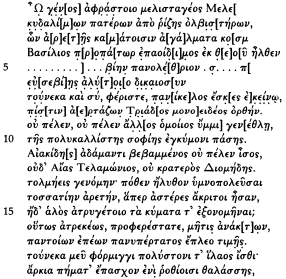
[32] Th. Gelzer, in Musaeus: Hero and Leander, p. 329 n. (b).
[33] See Shisha-Halevy, Coptic grammatical categories, pp. 11–14, 15–60 on the modifier; 163–164 on not "word" but "syntagm."
[34] T. Save-Söderbergh, Studies in the Coptic Manichaean psalm book (Uppsala 1949), esp. 1–10, 88–90. H. Junker's metrical comments in Koptische Poesie des 10. Jhdts. (Berlin 1908–1911) deal with much later material; but even there the concepts of "modifier" and "syntagm" apply.
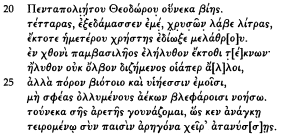
1 CF. P. Cairo Cat. II 67184 B 16
sup. Ma 2 cf. 4,4 3sup. Ma 4 cf. 14,4 | ad hunc versum in margine dextro verticaliter hae litterae scriptae sunt:. . .. . .... . .. . ... . .6 cf. 3,69 8 cf. 1 verso 6 et 3,41 9 cf. 2,3 10 cf. 1,18 13 cf. 12 B 18 et 5,11s 16 cf. 2,1 17 cf. 4b 9 18=192123 cf. 2,4 |supra24–26 cf. 4, 17–19 28 cf. 3,24
O descendant of Mele(), honey-sweet beyond words, sprung from renowned ancestors from the stock of the blessed, from among whom your famous forebear Basil came from God, (bringing) the ornaments of excellence (out) of troubles, . . . destructive force . . . the justice of indissoluble piety. . . . And so you too, honored one, have come, so like him, exalting the right faith of the Trinity, single in essence. Never, never was there anyone like you in noble birth, quick with every kind of beautiful wisdom. Even when Achilles was dipped in the fire he was not equal to your unconquerable self, nor was Telamonian Ajax, nor brave Diomedes. Let me be bold: whence should I begin to celebrate such great excellence, great as the stars are numberless, as if I could name the waves of the unharvested sea? In so accurate a sense are you, Your Excellency, craft of rulers, exalted and fully worthy of eloquence of every kind. Wherefore be gracious to my loud lyre; I have suffered enough troubles on the breakers of the sea, because of the violence of Theodore of the Pentapolis. They overwhelmed me (saying) "Take four pounds of gold," since when my creditors have driven me from my house. In the land of the emperor I have been (like) one without a fatherland; I have come, not, like others, seeking riches, but seeking a means of living for my sons as well, so that I do not with my eyes behold them perishing. And so I beseech Your Excellency, stretch out a helping hand to one who, together with his sons, is oppressed by need.
In this poem, Dioscorus's earliest, the autobiographical element is strong. He is seen here to make first use of elements and themes that will appear in his oeuvre for more than twenty years.
1. Besides Maspero's



It is not certain if the addressee was a duke of the Thebaid. Cf. J. Diethart, Prosopographia Arsinoitica (Vienna 1980), no. 3471.
4. The Basilius in question may be a member of one of the most powerful families in Late Antiquity; see A. Cameron and D. Schauer, "The last consul: Basilius and his diptych," JHS 102 (1982) 33–59; cf. D. Schauer, "The consular diptych of Basilius (V5) re-evaluated," Seventh BSC Abstracts (Boston 1981) 56–57, and now R. S. Bagnall, A. Cameron, S. R. Schwartz, and K. A. Worp, Consuls of the Later Roman Empire (Atlanta, 1987) 616–17. Cf. also Vettius Agorius Basilius Mavortius, cos. 527 (PLRE II, pp. 736–737).
6. For

8. Cf. H3.41; see L. S. B. MacCoull, "A Trinitarian formula in Dioscorus of Aphrodito," BSAC 24 (1982) 103–110, and eadem, "


10.

11. Cf. Apollonius Rhodius 4.869–879 (ed. F, Vian [Paris 1981], 178).
13.

19. . . .

20. For Theodore, bishop of the Pentapolis, see P.Cair.Masp. II 67168 (undated), and J. G. Keenan, "The Aphrodite papyri and village life in Byzantine Egypt," BSAC 26 (1984) 51–63. The "five cities" were Ptolemais Hermiou, the metropolis, south of Atripe (Sohag) on the west bank, famous for its heritage as an autonomous Greek city; Thinis, the old nome capital; and probably Diospolis Parva, Tentyra, and perhaps Abydos. For Ptolemais, see P.Flor. III 377.21; for the Pentapolis, see P.Fuad 86.2 and J. Gascou's comments in "P.Fouad 87: les monastères pachômiens et l'état byzantin," BIFAO 76 (1976) 159–160. We do not know why Bishop Theodore, a businessman who dealt in wine with a Pachomian house in the Hermopolite, had demanded the sum of 288 solidi from Dioscorus.
21. The large sum of 288 solidi apparently was a bone of contention in the matter of Dioscorus's journey to the capital. Compare PSI I 76, the case of Fl. Christodote in A.D. 574; and J. G. Keenan, "The Case of Flavia Christodote," ZPE 29 (1978) 191–209.
23. Read Dioscorus's own correction


[35] See R. Reidinger, ed., Concilium Lateranense 649 (ACO II 1, Berlin 1984) 425.

24. On this topos, cf. C. B. Welles, "The garden of Ptolemagrios at Panopolis," TAPA 77 (1946) 192–206, esp. 202–203.
In combining the craft of poetry (to ameliorate his condition) with a local public career and with travel, Dioscorus was following in the footsteps of his illustrious earlier countrymen Olympiodorus, Pamprepius, Cyrus, and, of course, Nonnus, as described at the beginning of this chapter.[36] Dioscorus can now be seen as not unworthy of that company. He is using hexameter form for a rhetorical production embodying Menander Rhetor's prescriptions for an epideictic praise speech:





H8. Encomium. A.D. 553? P. Walters 517
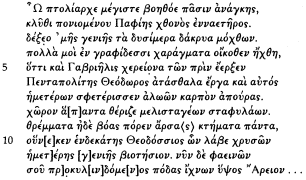
2 cf. 3,54 4 cf. 3,34 6 cf. 6,20 8 cf. 25,5 9 add. Ke 10 cf. 6,21| ad causam v. P. Cairo Cat. 67024,1–17 et Mal l.c. 12 cf. XXXVI recto a 18
O lord of cities, great helper of all in need, hear a troubled dweller in the land of Aphrodito. Receive the tormented tears of my family's troubles. I
[36] This world has been elucidated by Alan Cameron from "Wandering poets,' pp. 470–509, to "The empress and the poet," pp. 217–289.
brought many stamped documents from home, which Gabriel dismissed as worse than the old ones.
Theodore of the Pentapolis himself in his presumptuous evil deeds stole for himself the harvest of my threshing floors. (Do you) reap the whole estate of honey-sweet grape clusters. Come and water all the property that raises cattle, on account of which Theodosius took the revenue of the eleventh indiction, my family's support. And now I prostrate myself at your feet, before the warlike grandeur of your shining footsteps. . . .
2.

3.

4.


5. Gabriel, and 10. Theodosius, cannot be identified from the papyri as yet.
6. Once more Theodore of the Pentapolis, Dioscorus's clerical villain.
[39] K. Weitzmann, ed., Age of Spirituality: A symposium (New York and Princeton 1979) no. 288, pl. IX, pp. 313–314; M. C. Ross, Catalogue of the Dumbarton Oaks Collection II (Washington, D.C. 1965) no. 12. Compare the Coptic Museum Aphrodite-on-shell: J. Beckwith, Coptic sculpture (London 1963) pl. 62. See also K. Wessel, Coptic art (New York 1965) pl. 38 and 39.
Does the mention of grapes in line 8 suggest that Theodore was again dealing in wine at Dioscorus's expense?
10. The eleventh indiction in question is doubtless A.D. 547 (Bagnall and Worp, CSBE, 88).
11–12. Salutations to the addressee's "footsteps" have many parallels in Coptic epistolography; e.g., Ep 247, 300. Cf. H. Zilliacus, Zur Abundanz der spätgriechischen Gebrauschssprache (Helsinki 1967) 79. On the beauty of woman's feet in Late Antiquity, cf. Colluthus 135.
12.

H12. Iambic prologue and hexameter P.Rein. II 82 +
encomium on Romanos. P.Lit.Lond. 98
A.D. 553/4?
A
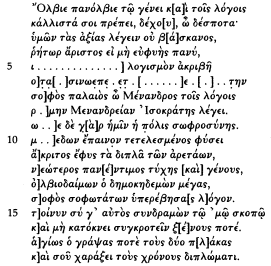
acrostichum:
.— 3 cf. 1 verso 2s et XXX 28 7s codex Menandri Cairensis (v. A. Koerte, Menander I, 3 1957, p. VIII) et vita Isocratis (P. Cairo Cat. 67175) Dioscori fuisse verisimile est. cf. etiam 9,16 |sup. Co contra acrostichum;,(=),? 12 cf. 10,6 14 cf. 4b 9 15 cf. 10,19 17s cf. 5,38s
B

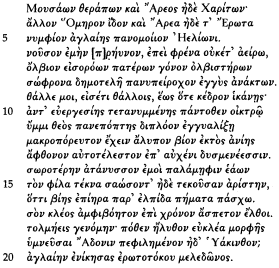
acrostichum:
.— 2b supraP cf. Eurip. Med. 844 3 e.g. cf. I 443, h. Ap. 131, Archil. fr. 1 4 cf. 25,6 5 cf. Septuag. Ps. 18,6 (? v. 1 verso 8) 5s alter versus delendus? 8 cf. 3,36 9 cf. 2,29 | cf. 2,25; 3,36; 4,12 |v. e.g. Septuag. 3. Reg. 5,13; Ps. 91,13 13 cf. 4,11 14 cf. 3,24 |a verboderivatum esse videtur; cf.. 16cf. 3,88 18s cf. 6,13s
Blessed one, all-blessed, in lineage and in mind, receive, my lord, the beauty that is your due. It is not for the envious to recite your worth. The most skilled of speakers, let alone the most eloquent, . . . (would hardly frame) an accurate speech (about you). Menander, the ancient thinker, (might have) in his sayings, and Isocrates (would. have) echoed Menander. (You are) to us the City of Wisdom. By your nature reckoned among those worthy of a panegyric, and subject to no judge, you furnish a double kind of excellence, (being) a young man all-honored by fortune and by descent, great patron of the people, blessed in spirit; in your wisdom you have surpassed the thought of the wisest. And now you yourself, deigning to behold me, do not shrink from helping strangers. May He who in His holiness once wrote the two Tables of the Law write many years in your Book of Life.
You were totally filled with an ordinance of far-ranging intent, O much-loved answer to the prayers of those who love divine wisdom, serving the Muses and the Graces as well as War; I have seen a second Homer, and Ares, and Love, Festivity's bridegroom, namesake of the sun. Soothe my illness, since I am not in my right senses, beholding the blessed descendant of most blessed ancestors, the wise ruler, who is close to the supreme sovereign himself. Flourish, and may you again flourish, till you resemble a cedar; for God Who sees all things has put into your hands a double
return for your beneficence, in mercy extended everywhere, and granted you a long and painless life, free from grief, unblighted by envy and rounded in accomplishment, free from troubles round your neck. Stretch out to me your hand that heaps up good fortune, saving my dear children and their excellent mother, because in my land tenure I am suffering the unexpected troubles of violence. May your renowned glory continue to an innumerable time. Let me be bold: Where should I begin to sing of Adonis, famous for his beauty, or beloved Hyacinth? You have surpassed the splendor of Aphrodite in her care.
Romanos unfortunately cannot be identified from the papyri; he is likely to have been a duke of the Thebaid (cf. A13, B8).
A1. A brilliant opening line, praising just those qualities most desired in an Egyptian noble: it creates a world of highly visible opulence that reaches back to the praise poems of Pindar. The delight in noble lineage and fine speaking (following the rhetorical precepts of







[41] Compare the remarks of Cameron, "The empress and the poet," p. 272; and P. R. L. Brown, The making of late antiquity (Cambridge, Mass. 1978) 81–82, with n. 2 (quoting H.Torp). The persistent drawing of false antitheses (of "Christian/pagan," 'Hellenic/Coptic" and the like) by critics perpetuates the value judgments of earlier periods. The present work seeks to free the reader's mind from such built-in idiosyncrasies.
3. On the evil eye, cf. H23.21, and see D. Bonneau, "L'apotropaïque 'abaskantos' en Egypte," RHR 199 (1982) 23–36.
7–8. As A. Körte noticed in Archiv 14 (1941) 111, Dioscorus owned both the codex of Menander now at Cairo, see L. Koenen et al., The Cairo codex of Menander (P.Cair.J. 43227 [London 1978]), and the papyrus containing a life of Isocrates (P.Cair.Masp. II 67175; see chapter II). The implication is of excellence in both (gnomic) wisdom and statecraft. For Dioscorus and the Menandri Sententiae, see my comments on H10.25.
9.






13. The noble patron par excellence, opulent and magnanimous.
17–18. Previous critics appear to have missed the point of this original and striking image. Collart in P.Rein. II (1940) thought the reference paralleled that of





B1.


2. Read the poet's original

3. The

4. On Dioscorus as owner of Homer MSS, cf. P.Cair.Masp. II 67172, 67173, 67174.
5. The "bridegroom of Festivity/Splendor": cf. Ps. 18:6 LXX, the unforgettable image of the sun as a bridegroom, "rejoicing as a giant to run his course."
8.

9. The cedar is of course a biblical (Old Testament) image (so Keydell in RE Suppl. 6 [1935] 28); to Heitsch's note, add Num. 24:6, Cant. 5:15, Ezek. 17:23.
11. Note again the juxtaposition of Christian and Roman-law terminology.
12. 
15. We do not know the identity of Dioscorus's wife.
16. I take this to be a reference again to the oppressions of Theodore of the Pentapolis (see my comments on H6 and H8). Such an identification would date the poem, and Romanos, to the early period, about 553/4, considerably before Dioscorus's move to Antinoë.
19. Hyacinthus: cf. comments on H27. Perhaps there was also an implied assimilation of the figure of Antinous to that of Apollo's beloved.
H1. Panegyric on the emperor Justin II. P.Cair.Masp. II 67183
A.D. 565/6
recto
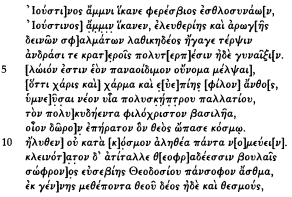

Iustinus II (aa. 565–578) Aegyptum numquam adiit; quare carmen ad adventum effigiei imperatoriae pertinet.—omnia sup. Ma.— 5s e 20,5s sup. Ma, cf. 3,13 7 cf. E. Kornemann, Weltgesch. d. Mittelmeerraumes II 445 10 cf. 2,23; 3,50; (14,2); 21,26; B 214 11
[in margine dextro sup. Cr 12 Theodosius I. (379–395) 16sup. Ma | cf. Nonn. D. 37, 103 18 cf. 6,10
verso
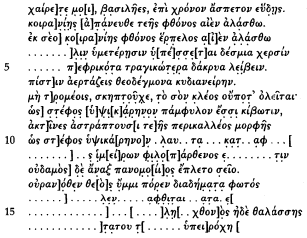
1 de confusione plural. et sing. cf. e.g. 5,33; 6,9s; 17,14s; 23,14; 24,18.21|
2s alter versus delendus, cf. 8. 10; 2,2.7s–11s; 4,3; 10,33; 12B 5s; 13,9s: 17,15s. 23s; 19,8.11; 24,12s | cf. 23,21 et 12,3 5 cf. Nonn. D. 47,228 6 cf. 6,8 7, cf. Nonn. D. 29,56 | cf. 4,7; 7,10; 20,1 8= arca Noae (Ke); cf. 12B 5.9 9, cor. Ke cl. 20,3
Further notes: r1 read
11 in apparatus addMa. 13Pap. v2. in right margin 9 read
Justin is come to us, the life-giver, bringer of good, Justin is come to us: he has brought to brave men and their happy wives the joy of freedom to banish care and of help for our painful failures. It is a fine thing to celebrate his name, worthy of poetic praise, as Grace does and Joy and the lovely flower of Eloquence, to sing the young son of the many-sceptred palace, the much-praised Emperor who loves Christ, which delightful gift God has granted to the world. He has come to shepherd all truth, not
according to worldly standards. He has cherished with his divinely spoken counsels the most renowned wise breath of prudent and pious Theodosius, following from his birth the fear and the ordinances of God, and he knows how to wear the purple robe of the holy bearers of Christ. Come now, Duke of the Thebaid, call your subjects. You alone are . . . , and you bring gifts of renown. Behold everywhere the wise root of the stock of sovereignty, big with the statutes of glorious wisdom, a splendid successor to the throne of former Emperors. Rejoice with me, O sovereigns; may you reach a boundless length of life. May the evil eye ever be banished far from your reign (may creeping Envy ever be banished from your reign). It is in your hands to loose our bonds . . . (as) in our fear we shed tears of sorrow. You exalt the divine faith which glorifies mankind. You who bear the sceptre, do not fear, your glory shall never fade: like a crowning garland, you are the universal Ark of the Covenant, and the rays of your beautiful voice flash out, like a crowning garland . . . lover of Our Lady. . . . Never has there been a ruler like you. God has sent you from heaven a crown of light. . . .
Dioscorus began his "Antinoë period" in 566, with this poetic work celebrating the adventus of the emperor's image (most likely a panelpainted icon) at the capital of the duke of the Thebaid, in honor of the new reign. Fittingly, in a poem on an imperial subject by a writer who had personally seen the imperial capital, it is filled with striking imagery rooted in the Egyptian poetic tradition, the Scriptures, and Dioscorus's own experience. Most abundant are epithets shared with the Nonnus Paraphrasis of St. John (e.g.,









r1 .

7.palatium: one of several examples of how Dioscorus was making
Latinisms respectable in poetry (e.g., P.Cair.Masp. II 67185 Al,



8. On


12. On the legislation, especially the novels, of Justin II, see Zepos and Zachariae v. Lingenthal, Jus graecoromanum I (Athens 1931, reprint Aalen 1962) 1–13: the emperor reintroduced divorce by consent. Novel 2 attests the presence of the

v2–3. "Alternate" lines in Dioscorus are not always to be discarded, in the manner of earlier critics: cf. Nonnus Paraphr. 18.33–34. The repetition is effective.
8. The most famous sixth-century Ark of the Covenant was of course that of the theories of Cosmas Indicopleustes, a figure of the universe: W. Wolska-Conus, Cosmas Indicopleustès: Topographie chrétienne III (SC 197, Paris 1973) 124–125 and pl. 6a.
15. Cf. Heitsch II S 10 (P.Berol. 9799) r14, with T. Viljamaa, Studies in Greek encomiastic poetry of the early Byzantine period (Helsinki 1968) 52. For a possible echo of the Coptic legal phrase

With this poem and the next (H10, to Victor the praeses ) begins Dios-
[42] The phrase was normal and well established at the Antinoë chancery; cf. P.Cair.Masp. I 67009 I 1, 67005.5 (restored), 67019.6, 22, III 67289B. It is found in chancery Greek as late as P.Apoll. 69.3. In Coptic, and from a nearby area, it is found at Bala'izah: Bal 191, 197, 227, 273. Other Coptic evidence is late and rather peripheral: BM 449.2 and 450.1 from Syene, 464.1 from Jeme (cf. 514, ninth-century liturgical).
corus's Antinoë period, upon his change of residence from Aphrodito to the seat of the duke of the Thebaid (cf. L. S. B. MacCoull, "Dioscorus and the dukes: an aspect of Coptic hellenism in the sixth century," BS/EB 14 [1988]).
H10. Encomium on Victor the prefect. A.D. 566/7. P.Cair.Masp. II 67131
A
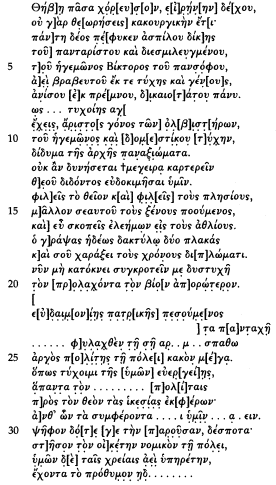
1–3 cf. 3,9–11 4 cf. 3,5 6 cf. 12,12 10 domesticus: titulus 12
coni. Ma 14s cf. 17,13; 18,4s |etolim Ma 17s cf. 5,38s |19 cf. 12,16 25 = P. Flor. III 295,6; cf. Eurip. fr. 512,'(v. etiam Eurip. El. 80, fr. 187). post 25 paragraphus. 33in marg. dextro
B
versificator in margine dextro mutationem scripsit hanc:
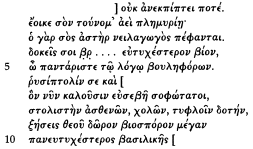
2s cf. 3,42s 5 cf. 17,1
Let the whole Thebaid dance and welcome peace, for you shall not behold evildoing any more; for fear of the spotless justice of the most excellent and polished prefect Victor the Wise has sprung up everywhere, who is ever a judge by fortune and descent, from unequaled stock, entirely most just. . . . You enjoy, O excellent descendant of blessed ancestors, the positions of both prefect (hegemon ) and domesticus, twin high offices of state. I would not be able to bear . . . if God did (not) grant me to glory in you. You love God and you love your neighbor, and in your state of life you love strangers better than yourself, and in your generosity you look with kindness upon the poor. May He Who in His divine courtesy wrote with His finger the two Tables of the Law write many years in your Book of Life. Now do not shrink from helping me in my trouble, I who have hitherto had allotted to me quite a difficult life. I fall before your high-born prosperity. . . . (As the saying goes,) a lazy citizen is a great evil to his city. So let me obtain the benefit of your benefaction . . . bearing prayers to God. Instead of which events have. . . . Give me then your present resolve, my lord: establish your client as notary in the city, ever an attendant upon your wishes, willing to . . . (serve them . . .)
Your name is ever like the inundation of the Nile; and indeed your star has appeared to lead the Nile. You seem . . . a most happy life, O most excellent in mind of counselors. (I call you) savior of cities, and now the wise call you pious, who clothe the poor and the melancholy, benefactor to the blind; you shall obtain from God the great gift of propagating life, O most fortunate of royal . . .
In this poem Dioscorus is anticipating the beginning of his career as nomikos (A31) at Antinoë, a work he probably began in early 566 (or perhaps 567; cf. P.Lond. V 1674 pref.). It is a new poetic departure in several ways.
A1–2: This is the first time (of four) that Dioscorus will use his favorite opening line for iambics (cf. H9, H11, and culminating in H3, the ode to Duke John). For the Late Antique iambic, see Alan Cameron, "Pap.Ant. III.115 and the iambic prologue in late Greek poetry," CQ 64 (1970) 119–129. Because so much metaphrastic and cento poetic work has been shown to be Egyptian (Golega, Der homerische Psalter, pp. 31–34), the non-Euripidean portions of the Christus Patiens are also worth investigating from this perspective.[43]
On the iambics, see also A. Saija, "La metrica di Dioscoro di Afroditopoli," in Studi in onore di A. Ardizzoni 2, ed. E. Livrea and G. A. Privitera (Messina and Rome 1978) 840–844.
Compare Nonnus Dion. 5.119 (Thebes as the dancing-ground of the Olympian gods).[44]
3.

4–9. The qualities of the praeses are described in proper rhetorical order. Cf. H11.4.
10. For domestici at Antinoë, cf. P.Cair.Masp. I 67005v3, II 67179.1, III 67330 IV 6; P.Lond. V 1672.4.
12. Probably

14–15. Cf. P.Lit.Lond. 100G, echoing Christ's teaching. On the problem of "who is my neighbor?" in Late Antiquity, especially in Egyptian village society, see Brown, Making of late antiquity, 77. On

17–18. The reference, as in H12.17–18, is not to consular diptychs (so Maspero in P.Cair.Masp. II 67131, p. 15n.), but to the two Tables of the Law.
[43] Treated by L. S. B. MacCoull, "Egyptian elements in the Christus Patiens, " paper presented at the Tenth Byzantine Studies Conference, Cincinnati, November 1984; published in BSAC 27 (1985) 45–51. A. Tuilier's edition of the Christus Patiens (Paris 1969), in which he favored the traditional attribution to Gregory Nazianzen, was not well received; see the critique by J. Grosdidier de Matons in Trav.etMém. 5 (1973) 363–372. F. Trisoglio's edition (Rome 1979) was preceded by numerous articles but of a purely literary-critical nature. I hypothesize that the Christus Patiens was composed by an Egyptian poet ca. 500.
[44] On the seven-gated Thebes of Hellas and the hundred-gated Egyptian Thebes in Late Antiquity, see K. Weitzmann, Greek mythology in Byzantine art (Princeton 1951) 35; cf. S. P. Brock, The Syriac version of the pseudo-Nonnus mythological scholia (Cambridge 1971) 81. On the Egyptian self-image as related to classical antiquity, cf. G. Bardy, "Le patriotisme égyptien dans la tradition patristique," Rev.d'Hist.Eccl. 45 (1950) 5–24, which stops before Chalcedon. Present-day scholarship would tend to disagree with his conclusions. It is also unfortunate that the paper by W. H. C. Frend, Nationalism as a factor in anti-Chalcedonian feeling in Egypt," SCH 18 (1982) 21–38 is based only on the same old narrative sources, not on documentary papyri.
Compare also the iconography illustrated in Wolska-Conus, Cosmas Indicopleustès: Topographie chrétienne I (SC 141, Paris 1968) 99, 193, fig. 8.
19.

25. This proverb in this form is not contained in the collections of Menander's Monosticha that we have (ed. S. Jaekel, Teubner, Leipzig,, 1964); see D. Hagedorn and M. Weber, "Die griechisch-koptische Rezension der Menandersentenzen," ZPE 3 (1968) 15–50. Dioscorus uses it elsewhere, in prose, in P.Flor. III 295.6.[45] (Cf. W. Crönert in Gnomon 2 [1926] 660 adducing Vitelli's note to the line in P.Flor., as well as the Euripides parallel noted by Heitsch.[46] ) Dioscorus loved the proverbial (cf. the opening of P.Cair.Masp. II 67151, the will of Fl. Phoebammon); Zilliacus, Abundanz, pp. 13–14. A possible echo is preserved in the Arabic: M. Ullmann, Die arabische Überlieferung der sogenannten Menandersentenzen (AKM 34.1, Wiesbaden 1961) 33, no. 133 (but the Arabic word corresponding to



31. Dioscorus is asking for an official position at Antinoë. On the office, cf. H18 and P.Lit.Lond. 100F, on John the nomikos.
B3.


[45] I am grateful to Dr. Rosario Pintaudi of Florence for providing a photograph. The Florence papyrus cannot be dated precisely from the prosopography (Apa Besas the numerarius, Thomas the pagarch of Antaeopolis), but probably belongs to before 551, hence containing Dioscorus's earlier use of this proverb; cf. the oikos Psintse, to be identified with the topos and monastery of Psintase in P.Freer 2 I 24, II 1; 1 VII 1 (?).
[47] Cf. also G. Kraemer, "Arabische Homerverse," ZDMG N.F. 31 (1956) 259–316; H. Satzinger, "Zu den koptischen Menander-Sentenzen," Cd'E 47 (1972) 351–354.
be referring to the comet seen in Egypt from Mesore to Thoth of year 281 of Diocletian (September–October A.D. 565), recorded by Olympiodorus In Meteor. I.6 (ed. W. Stuve [CAG 12.2, Berlin 1900] 52.30–53.2), surely taken as a portent of the approaching death of Justinian. Star imagery was a graceful sort of compliment: cf. in W. M. Calder, Monumenta Asiae Minoris Antiquae 1:238 (Manchester 1928), the epitaph of a priest,




6.

[49] Cf. O. P. Nicholson, "Lactantius: Prophecy and politics in the age of Constantine the Great" (D.Phil. thesis, Oxford 1981) 130–133 with notes; L. S. B. MacCoull, "The imperial chairetismos of Dioscorus of Aphrodito," JARCE 18 (1981–85) 44-45 with nn. 20–21.
[50] The Brooklyn Museum relief (acc. no. 62.45) may well be a city goddess or an allegorical representation of a personified Byzantine Egyptian city.
might recall also the concept of rejuvenation reflected in Pamprepius 3.11; cf. E. R. Curtius, European literature and the Latin middle ages (Princeton 1953) 103–105.
8. Cf. Mt 25:35–40.
H24. Epithalamium for Paul and Patricia. P.Lit.Lond. 100C
Ca. A.D. 566.
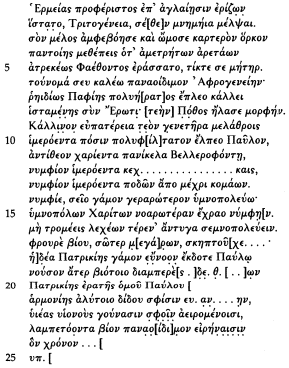
acrostichum:
.— 1supra[3–5 'Complete collapse of grammar, The idea appears to be that since Patricia is such a paragon, her existence can only be explained by supposing that her real father is Phaethon.' Mi 8 postinterpungendum? 9s,, cf. 22,5 11 cf. 2,20 12s alter versus delendus 13 in marg. dextro | cf. II 640; AP V 194,3 15? 17 Iuppiter invocatur 19? 22 cf. 23,17
Come, Athena, who excelled when Hermes set up the contest of splendor; come to sing memories of you. So she cried your song aloud and swore a mighty oath to follow you everywhere, because clearly the mother who bore you was loved by Phaethon, so measureless is your excellence. I call upon your name as most worthy of song of all the daughters of Aphrodito; surely you are full of the beauty of beloved Aphrodite who stands by Love's side; longing has marked your loveliness. Your noble descent from the house of Callinus your father has given hope to beloved Paul, your dear husband, godlike in his grace, like Bellerophon, a desired bridegroom . . . with hair flowing down to his feet. Bridegroom, I praise your noble wedding; you have taken a bride wiser than the hymn-singing Graces. Do not be afraid of your soft marriage-bed's solemnity. Watch over their life together, O savior of homes, sceptered one. . . . Give Paul a pleasant and happy marriage with Patricia, a life quite without illness. . . . Paul and beloved Patricia. . . . Give them the . . . of indissoluble harmony, as they hold children and grandchildren on their laps, and a bright and peaceful life, worthy of poetic praise. . . .
This is Dioscorus's first epithalamium, a genre he will come to practice often. Milne's identification of the bride with Patricia the pagarch (cf. P.Lond. V 1660, ad P.Lit.Lond. 100C) makes sense and probably should be accepted.
1. One thinks of Hermes's role in the Judgment of Paris, conducting the goddesses to Mount Ida.[52] The same content is seen in Colluthus 77–79. Compare the Princeton relief of the Judgment, if this interpretation be correct; F. F. Jones, "Six pieces of sculpture," Record Art Mus. Princeton Univ. 21 (1962) 53–55; J. H. Turnure, "Princeton's 'enigmatic' relief,' ibid. 22 (1963) 45–57, with a different, Christian interpretation; H. Zaloscer, Die Kunst im christlichen Ägypten (Vienna 1974) pl. 48: Athena stands in the central position, with a cross on her shield. Cf. also the Coptic textile of the Judgment of Paris in the Kevorkian Foundation (Brooklyn Museum, Pagan and Christian Egypt [New York 1941] no. 235), complete with star imagery. Read, as last word,

3. Compare oath formulas in Byzantine Greek and Coptic papyri, e.g., the

[52] Disregarding Milne's "erotic associations." For Hermes's role in the Judgment of Paris in ancient art, see J. Henle, Greek Myths: A vase painter's notebook (Bloomington 1973) 127–130; 193 nn. 8–9, 13; cf. C. Clairmont, Das Parisurteil in der antiken Kunst (Frankfurt 1972) 22–23; F. Brommer, Vasenlisten z.griech. Heldensage (Marburg 1973) 459–460. Also cf. J. Trilling, The Roman heritage: Textiles from Egypt and the eastern Mediterranean, 300–600A.D. (Washington, D.C. 1982) no. 25, p. 46; and the ivory pyxis (sixth century) in the Walters Art Gallery, W. F. Volbach, Elfenbeinarbeiten der Spätantike (Mainz 1976) no. 104, p. 75 and Taf. 55.
im römisch-ägyptischen Provinzialrecht 2 (MB 24, Munich 1935), esp. 137–160.
4.

5. Dioscorus is fond of the myth of Phaethon; cf. H20.3, which may provide an identification for the bridegroom in this poem, as it is addressed to one Paul, son of Domninus, cancellarius on the prefectural staff (see later comments). This Paul is probably the same person. Dioscorus had most likely read the Phaethon story in Nonnus Dion. 38.90–95. The young man fallen from the Sun's chariot does not seem to have been popular in Late Antique visual art (see Leclercq in DACL 14.1 [1939] 660–664, who does quote an undated inscription from Palestine containing the phrase


6–7. Note the sequence '


8.


9. Callinus: his identity cannot be fixed from the papyri of the Aphrodito/Antinoë region.
11. Bellerophon, first introduced here and later mentioned in other epithalamia and in an encomium (H21, H32, H2), is a favorite figure of Dioscorus. On the symbolism of "Bellerophon Christianus," taken as a type of the victory of good over evil, see G. M. A. Hanfmann, "The continuity of classical art: culture, myth, and faith," in Weitzmann, Age of spirituality, pp. 85–87, with figs. 19–21 and the literature cited in nn. 58–67, esp. M. Simon, "Bellerophon chrétien," in Mélanges Carcopino (Vendome 1966) 889–903;[55]
[54] On pothos, see A. B. Bosworth, A historical commentary on Arrian's history of Alexander I (Oxford 1980) 35 n. 10, and esp. 62.
[55] See H. Brandenburg, "Bellerophon christianus," RomQ 63 (1968) 49–86, esp. the literature cited p. 51 n. 6; idem, review of Bellerophon by S. Hiller, JbAC 14 (1971) 163–168; J. M. C. Toynbee, "The Christian mosaic pavement, Hinton St. Mary, Dorset," JRS 64 (1964) 7–14; cf. W. H. C. Frend, review of Priscillian of Avila by H. Chadwick, JTS 28 (1977) 564–565 with n. 1. Bellerophon is depicted on the "Shawl of Sabina" in the Louvre, from Antinoë: Weitzmann, Age of spirituality, no. 112. The plaque illustrated in Volbach, Elfenbeinarbeiten, no. 67, is not from Egypt.
cf. I. Sevcenko[*] , "A shadow outline of virtue: The classical heritage of Greek Christian literature (second to seventh century)," in Weitzmann, Age of spirituality 57, with nn. 34–35, citing Methodius of Olympus. This imagery was very much alive in Dioscorus's poetic mind. The beauty of the heroic young Bellerophon in the London ivory (Hanfmann, fig. 21) is what he is praising in the person of the young bridegroom Paul (and will later apply to others, including the duke of the Thebaid).
13. Cf. Cant. 5:11, in context.
15. Note that the bride is praised for her intelligence; the Christianization of

16. Either the


17. In spite of Milne's reservations,

H18. Encomium on John the notary. P.Lit.Lond. 100F
Ca. A.D. 567.
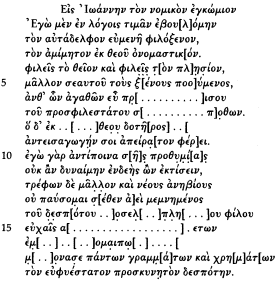
3 cf. Mi l.c. n. 100 G (encomium Johannis)
. cf. etiam 15,2; 17,11 4s cf. 10,14s
I wanted to honor in words one who is as close as a brother to me, kind and a lover of strangers, matchless, named from God. You love God and you love your neighbor, and rather you love strangers better than yourself, and for these good deeds . . . of the most kindly . . . from God the giver . . . (for) bringing in someone inexperienced. For I, being needy, would not be able to pay full requital for your kindness; but since rather I am also bringing up my underage children, I shall not cease from ever remembering you, dear master, in my prayers . . . (you) with your skill in words, bowed down to, master of letters and of wealth.
This poem and its companion piece P.Lit.Lond. 100G (following), as well as its immediate predecessor H24, the epithalamium for Paul and Patricia, are all to be found on the horizontal-fibers side of P.Lond. V 1709, Dioscorus's first (of two) Coptic arbitration contract. This document is dated from its correlate P.Cair.Masp. I 67006.101, which mentions a coming fifteenth indiction (which must be A.D. 566). The poem H18 is a thanksgiving to John, a member of the notarial staff through whom it seems Dioscorus found a job. Hence this group of literary works, together with the other Coptic arbitration hearing in P.Cair.Masp. III 67353r, all fall into the period A.D. 566–570 (see Chapter 2).
2.

3. Like P.Lit.Lond. 100G 1 and 9 (

13. As so often in Coptic letters,

17. The ideal patron, possessed of both learning and material influence.
18.

To John. Ca. A.D. 567. P.Lit.Lond. 100G
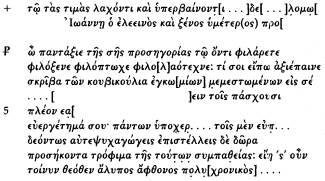
Heading. MS.
. 1 MS.,. 2 MS.. 3 1.. 6 MS.:orpossible. 7 MS.. 9 MS.from Cairo Masp. 67120 (F), 37, orfrom Cairo Masp. 67315, 57. It is possible, however, to read. . .
To John, whose portion is honor, the surpassing . . . (from) your poor stranger . . . O completely worthy of your name, in your being a lover of excellence, of strangers, of the poor, you who love to instruct the people in your craft: how, O praiseworthy one, shall I address you, as scriba of the cubiculum, since you have had your fill of encomia upon you? . . . to those who suffer . . . your benefaction . . . rightly you win over men's souls to yourself, and you send as gifts fitting nourishment of sympathy with these; so now may you be, from God, spared pain, generous, long-lived. . . .
This piece is not a poem in classical meter, but a work of rhythmic Kunstprosa similar to Dioscorus's P.Cair.Masp. I 67097 verso F, lines 17–27.
1–2. In the first two of these compounds, Dioscorus is praising John's professional ability and his hospitality to the poet (as in the previous poem, H18). On the connection of







3.Scriba is attested at Aphrodito in P.Cair.Masp. III 67353 v A 25; cubiculum does not appear outside of this text. See S. Daris, Il lessico latino nel greco d'Egitto (Pap.Castr. 3, Barcelona 1971) s.vv.
H25. Epithalamium for Athanasius, 566–570 P.Lit.Lond. 100D
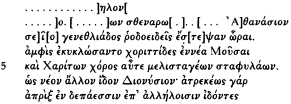
[56] Edited by A. Busse (CAG 18.1, Berlin 1900).

3 cf. P. Cairo Cat. 6717 A
(Nsupra). 6 cf. 12 B 4 |sc., cf. 23,11s 8 cf. 21,9 | Poseidon, fluminum dominus 11 cf.v. 6
. . . strong Athanasius . . . the rosy Hours crowned the day you were born. The nine Muses circled round you in their dance, and the chorus of the Graces, with clusters of grapes sweet as honey. I have beheld (you) as another new Dionysus; for truly those who looked upon the wine, Love's adornment, passing it closely in goblets one to another, have prayed to Poseidon the Nurturer for you, O bridegroom . . . At once I call upon you . . . the Nile . . .
This Athanasius may be identified with the man of that name whom Dioscorus will later hail as duke of the Thebaid, ca. 571, in H25 (P.Cair. Masp. I 67097 v B–C). This poem as well is on the other side of P.Lond. V 1709.
3. On

4. For the nine Muses in Late Antique art, cf. Volbach, Elfenbeinarbeiten, nos. 69–70.
6. Dionysiac imagery is beloved by Dioscorus (as noticed already by W. Crönert in Gnomon 2 [1926] 662–663, 666). The topic of Dionysiac imagery in Late Antiquity is vast; see V. F. Lenzen, The triumph of Dionysos on textiles of Late Antique Egypt (Berkeley and Los Angeles 1960). The subject, with comments, will recur in Dioscorus's later, and longer, encomiastic verses.
7–8. Cf. Proverbs 23:31 (Sahidic), . . .

8. Here Poseidon is assimilated to the Nile, father of rivers (line 11). The Nilotic river god is often depicted in Coptic art (Beckwith, Coptic sculpture, pl. 72–74; Zaloscer, Kunst im christlichen Ägypten, Taf. 30; Volbach, Elfenbeinarbeiten, no. 105).[58]
H21. Epithalamium for Count Callinicus P.Cair.Masp. II 67179
and Theophile. Before A.D. 570
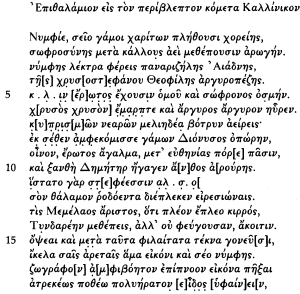
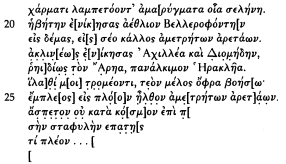
1 cf. 22,1–3; Nonn. D. 47,474 3 cf. 22,4 6 cf. 22,9; 23,24; Callim. fr. 75,30s 7 cf. Nonn. D. 7,339 8 . . .
. . . supra| cf. 3,42 | cf. Nonn. D. 47,501 9 cf. 25,8; Musae. 8 10 sup. Ma e P. Cairo Cat. 67178A9 11s cf. 25,3 12supra|[ supra| cf. Nonn. D. 37,77 14 cf. 22,19 |15supra, cf. Nonn. D. 2,328 17–19 cf. 2,16–18 20 cf. 2,20 21in marg. dextro 22s cf. 2,19–21 24s cf. 2,14s 26 cf. 1,10
Bridegroom, may your wedding be filled with the dancing of the Graces; may it ever seek the help of Wisdom after Beauty. You are marrying a bride who is an enviable Ariadne, silver-sandaled Theophile wreathed in gold. (May your marriage) have the scent at once of love and of wisdom. Gold has embraced gold, and silver has found silver. You raise up the honey-sweet grape cluster, in its bloom of youth; Dionysus attends the summer of your wedding, bearing wine, love's adornment, with plenty for all, and blonde Demeter brings the flower of the field. . . . They have woven holy wreaths round your rose-filled bedroom. Like splendid Menelaus, but more tawny colored, follow your Helen, a wife who will not leave you. And afterwards you shall see dear children on your lap, like both your excellence and your wife's to look upon. I wish a famous painter would accurately depict your lifelike image, with his craft to work your beloved likeness, whose bright beams flash with joy like the moon. Your young body has surpassed prize-winning Bellerophon, and your beauty is that of measureless excellence. To judge impartially, you have outdone Achilles and Diomedes, and easily outstripped Ares and brave Herakles. Be gracious to me in my awe of you, so I may sing your song: I came sailing on my voyage, inspired by your measureless excellence. Not in a worldly sense . . .
For Count Callinicus, cf. P.Antin. III 189.1–2.
In line 13 Heitsch's text is misprinted: read


1. Dioscorus is fond of this opening; cf. H22.
3.

Museum, Paris (Volbach, Elfenbeinarbeiten, no. 78, Taf. 44);[59] and Heitsch 39, a poem on the rising of the Nile, originally PSI VII (1925) 845.7 (dated by M. Norsa as fifth to sixth century [a papyrus codex leaf]).
4. We cannot identify Theophile or her family from the Aphrodito/Antinoë papyri. On


5. Echoing line 2,

6. A favorite line of Dioscorus for epithalamia. Both Heitsch (citing Callimachus) and B. Baldwin, 'Dioscorus of Aphrodito: the worst poet of antiquity?" Atti XVII cong.intl.papirol. (Naples 1984) 327–331, have missed the point. The allusion is to the sixth-century Alexandrian philosophical exegesis of the doctrine of the affinity of like with like. See John Philoponus, in De Gen. et Corr. II.2 (ed. G. Vitelli, CAG 16, Berlin 1887) 420, lines 7, 12–13. Callimachus's point was the union of superior as opposed to inferior elements. Dioscorus's Philoponian point is the union of two of the same kind.
For

8. Here is Dioscorus's Dionysiac procession, like that of the thiasos tapestry in the Metropolitan Museum (cf. H. E. Winlock, "A Roman tapestry and a Roman rug," Bull.Met.Mus.Art 27 [1932] 157–158) in which face after face rejoices with the spectator, in the manner of the sculptured heads in the ceiling at Mshatta (cf. Plotinus, Enn. VI 7 [38] 15, 24–26; A. H. Armstrong in The Cambridge history of later Greek and early Medieval philosophy [Cambridge 1967] 221:[61] "a living sphere of varied color and pattern, or something all faces, shining with living faces").
10. Cant. 2:1; cf. P.Cair.Masp. 67178.9. On the presence of Demeter, cf. Pamprepius 3.115.
13.


[59] Of course the most memorable Ariadne figures from Egypt are the Vienna textile (Wessel, Coptic art, pl. 113) and the Boston textile (Weitzmann, Age of spirituality, no. 125). The Cluny Museum ivory does not represent Ariadne, in the eyes of modern scholarship. Cf. also the ivory comb in Mainz: Volbach, Elfenbeinarbeiten, no. 88a.
[60] Compare L. J. James, "The spread of effect of the aesthetics of Dionysius the Areopagite" (Diss., Ohio State University 1976) 12–13 with notes; R. F. Newbold, "Perception and sensory awareness among Latin writers in late antiquity," Class.etMed. 33 (1981–82) 169–190 (though not treating Greek material for comparison); P. R. L. Brown, The cult of the saints (Chicago 1980) pp. 76, 82. For the "göttliche Wohlgeruch" in Nonnus's Metabole, cf. K. Smolak, "Beiträge zur Erklärung der Metabole des Nonnos," JÖB 34 (1984) 4; cf. Met. 12.16.
[61] Also compare the Antinoë Dionysiac tapestry—the thiasos in an Egyptian setting (Wessel, Koptische Kunst, pl. 107).
16. On children as eikones (images), in the Life of S. Thecla (ed. G. Dagron, SH 62, Brussels 1978) 5.37–38 we find, as a counter to the strange new Christian notion of the resurrection of the body, the widely held notion that the real resurrection is the natural human one through offspring:


17ff. On

20. On Bellerophon, cf. my comment on H24.11.
25. This too is a line Dioscorus will reuse often; cf. also Golega, Der homerische Psalter, p. 97, n. 1, with the literature there cited.


H5. Encomium on Duke Callinicus. Ca. A.D. 570+. P.Cair.Masp. III 67315
(See Figure 7)
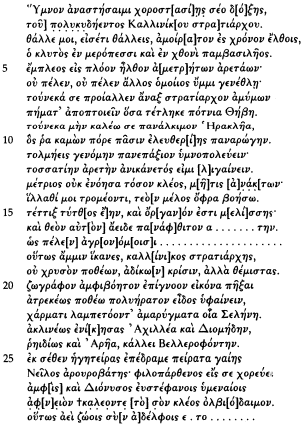
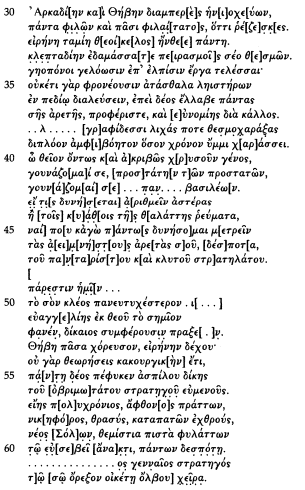
3 cf. 2,29 et 2,12 4 cf. 2,4 5 cf. 2,15 6 cf. 2,3 7s cf. 2,6s 9s cf. 2,21s 11 cf. 6,13 12 cf. 6,14; 13,16; 23,16 13 cf. 2,1 14 cf. 2,14 17 cf. 3,45 18 cf. 2,8 19 cf.13,11s; 14,5–7 20–24 cf. 2,16–20 24 cf. Z 156 25s cf. 3,42s |
=28?? 29 cf. 2,12 30 cf. 2,2 32 cf. 4 B 3 38s cf. 10,17s; 11,13s; 12,17s 40–42 cf. 3,1–3 43–46 cf. 9,10–13 5152velleg. Ma |vel|in marg. dextro 53–55 cf. 3,9–11 59 cf. 3,12 (et 3,37!) 62 cf. 9,20
Let me raise a hymn of the dance to your glory, all-renowned Duke Callinicus. Flourish and again flourish, and may you attain to a boundless length of life, O famous among men in the land of the Emperor. I came sailing on my voyage, inspired by your measureless excellence. Never, never was there anyone like you in high descent: wherefore the noble lord
has appointed you Duke, to drive away the troubles that Lady Thebes has endured. Therefore I call you all-brave Herakles, who has taken the trouble to bring the universal help of freedom to all. Let me be bold to celebrate (you), the all-worthy; I am not able to sing such excellence. Humbly I have not grasped such glory, craft of rulers; be gracious to me in my awe of you, so I may utter your song aloud. I wish I were a little cicada, or had the ability of the bee: even it sings of the imperishable God Himself. . . . So you have come to us, Duke Callinicus, fair in victory, not seeking money, the standard of the unjust, but seeking just judgments. I wish that a famous painter would accurately depict your recognizable image, with his craft to work your beloved likeness, whose bright beams flash with joy like the moon. To judge impartially, you have surpassed Achilles and Diomedes, and you have even outstripped Ares, and Bellerophon in beauty. Under your leadership the Nile that covers Egypt's fields has flowed forth to the limits of our land; the lover of maidens dances before you, (namely) Dionysus with his wreathed revelers . . . (invoking?) your rich and blessed glory. So you may live forever, with your brothers, . . . ever charioteer of Arcadia and the Thebaid, loving all and beloved by all, which is your accomplishment. Peace who keeps God's house has flowered forth everywhere. You have subdued robbery by the trials of your judgments. The farmers are happy, looking forward to the fruition of their tasks; for they do not think they will see the presumptuous evils of thieves in their land, since fear of your excellence has seized everyone, Your Excellency, through the beauty of good government. As you have engraved laws in writing . . . so may you mark them out for a double length of renowned time. O descendant of a truly divine and really golden line, I beseech you, patron of patrons, I beseech you, . . . of kings. If someone could number the stars or measure out the sea's floods with a spoon, then I could measure your ever-memorable excellence, my lord, O best and most renowned Duke. Your most fortunate glory . . . The sign of God's Gospel is come, a just man with seemly actions. Let the whole Thebaid dance and welcome peace; for you shall not behold evildoing any more, since fear of the spotless justice of the most mighty and beneficent Duke has sprung up everywhere. May you be full of years, bounteous in actions, victorious, brave, treading down your enemies, O new Solon, keeping faithful judgments before the pious Emperor, the ruler of all. The noble Duke . . . stretch out the hand of blessing to one of your household.
This poem is Dioscorus's first real full-dress encomium on a local official; we can see how the poet is paying attention both to the prescriptions for an epideictic oration as set forth by Menander Rhetor and to the requirements for praising a holy man in a Coptic sermon (cf. C. D. G. Müller, "Einige Bemerkungen zur 'ars praedicandi' der alten koptischen Kirche," Muséon 67 [1954] 231–270). Dioscorus both was trained as a good classical rhetor and was influenced by the preaching he had heard and the hagiography he had read.
In this encomium Dioscorus originates much of the phraseology that he is later to rework in his praise of Duke John (see H2 and H3, A.D. 574–576). It is a poem about justice and good government, and their effect on the economic troubles of Aphrodito that had helped drive Dioscorus to move to Antinoë (cf. Cameron, "Pap.Ant. III.115," pp. 125–127: "administration of justice was felt to be the prime function of a provincial governor").
3a. Cf. H12 B 9; here not with an Old Testament image but with a conventional wish for long life (cf. lines 29, 57).
6. A line Dioscorus likes to use, in following the prescript of Menander Rhetor by first treating of his subject's

8. Lady Thebes is again personified in H4, the encomium on Duke Athanasius (cf. H4, with n. 6a above on the Egyptian Thebes). Such a classical figure (cf. H10 B 6 for cities personified) is a compliment to the duke, who is being regarded as a man of cosmopolitan culture (cf. line 4).
9. M. Simon in Hercule et le christianisme (Paris 1955) has described the nuances and the Nachleben of Herakles as a Christ-figure.
11. Compare the

15. Here Dioscorus originates one of his most winning poetic figures, the hymn-singing cicada, a striking reworking of a Hellenistic conceit in a Christian context (see L. S. B. MacCoull, "John Philoponus and Dioscorus of Aphrodito," Studia Patristica 18 [Kalamazoo 1987] 1: 163–168, commenting on P.Berol. 13894). Since Plato (Phdr. 259) and Callimachus (Aet. 1.29–34, on the favorable atmosphere for poetry in Ptolemaic Alexandria), the cicada has been a metaphor for the poet (cf. Theocritus 1.148 and especially Anacreontea 34.18). Here the little insect sings

[62] Dioscorus very likely derived the figure most immediately from Menander Rhetor—a device of modesty; see the text edited by D. A. Russell and N. G. Wilson (Oxford 1981), sec. 391, pp. 118–119, 299. The commentators cite AP 9.380. See now L. S. B. MacCoull, "Dioscorus of Aphrodito and John Philoponus," Studia Patristica (Kalamazoo 1987), n. 19b, citing Jerome's cicada metaphor. P. Antin in Recueil S. Jérôme (Brussels 1968) 290n. gives numerous Late Antique literary references.
18. Note the pun on the duke's name.
19. Justice is once again the central theme of the poem.
20–21. Here again Dioscorus indicates what is regarded as desirable in portraiture (cf. L'Orange, "The antique origin of medieval portraiture"); to be compared with H21.17–18 immediately preceding. In the Callinicus epithalamium, H21, the likeness is to be



26.




29.

32. 

33.

37.

38.

40. On this quasi-Vergilian "golden line," see L. Koenen, "Zwei Inschriften aus El-Bagawat," ZPE 2 (1968) 75–80, esp. 76; E. Bernand, Inscriptions métriques de l'Egypte gréco-romaine (Paris 1969) no. 173 (pp. 725–630); cf. Christus Patiens (ed. A. Tuilier, SC 149, Paris 1969) 116 (Euripidean):

51. The justice of the duke, defender of the faith, is like the Good News (cf. P.Cair.Masp. I 67002 I 1–2, a passage treated by H. I. Bell, "An Egyptian village in the age of Justinian," JHS 64 [1944] 33).
53.

60. On Justin II as both moderate (at least before 572) and pious, see Averil Cameron, "The early religious policies of Justin II," SCH 13 (1976) 51–67, reprinted in Continuity and change in sixth-century Byzantium (London 1981) no. 10.
H13. Birthday poem on Colluthus. P.Cair.Masp. I 67120 v B
(See Figure 8)
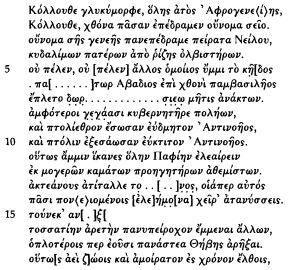
[65] On gold, see S. Averincev, "L'or dans le système des symboles de la culture protobyzantine," Studi medievali 20 (1979) 47–67—idiosyncratic but interesting. I owe this reference to Peter Brown.

1
, cognomen imperatorum 2s cf. 5,25 3 de composito cf. 2,22 4 cf. 4,4 5 cf. 2,3 6 cf. 2,4 |cf. 17,5 9s mutationes 11 cf. 2,8 | cf. 14,5–7 12supra13? Keyd 14 cf. 3,54 | cf. 3,24 16 cf. 5,12 17 cf. ad 3 18 cf. 2,12 19 cf. 2,30 20s cf. 17,20–24
Colluthus, fair to look upon, eagle of the whole land of Aphrodito, Colluthus, your name has overspread the whole earth. The fame of your lineage has reached as far as the sources of the Nile, O descendant of renowned ancestors, from the stock of the blessed. Never, never was there anyone like you in noble birth. . . . Abadios in the land of the Emperor . . . craft of rulers. Both were captains of cities, and saved well-built Antinoë (they saved Antinoë, good to dwell in). So you have come to us to take pity on the whole land of Aphrodito, suffering from lamentable troubles at the hands of unjust administrators. Be a foster father to the poor . . . , as you yourself stretch out a generous hand to those in trouble . . . that you are supreme over all others in such excellence, you who have helped all the cities of the Thebaid, poor though they be. So may you live forever and reach a boundless length of life, with your dear children and admirable wife, and your kinsmen Callinicus, Dorotheus, and honored Mark, the judge eminent for his understanding.
This birthday poem introduces a small group of encomia on the relatives of Duke Callinicus (cf. H5.29).
Colluthus (cf. W. E. Crum, "Colluthus, the martyr and his name," BZ 30 [1929–1930] 323–327), kinsman of Callinicus, Dorotheus, and Mark the judge, appears to have been an administrator at Antinoë (lines 9–10); he is also the recipient of H17, where he figures as pagarch of Antaeopolis. See L. S. B. MacCoull, "Additions to the prosopography of Aphrodito from the Coptic documents," BSAC 25 (1983) 91–94; and the forthcoming edition by L. Papini and L. S. B. MacCoull of P. Vaticani Copti Doresse, the Aphrodito Coptic papyri that were given by Jean Doresse to the Vatican Library. Colluthus and Mark together are mentioned in P.Vat.Copti Doresse 5 I 2–3, II 35; the signer, Taham daughter of Promauo, refers to her "late husband" Mark in I 8–9, II 32–33, which may date the Coptic document later if the identifications hold.
S. Colluthus was the patron saint of Antinoë (see L. Papini, "Due biglietti oracolari cristiani," in Trenta papiri greci, ed. M. Manfredi [Florence 1983] 68–70).
1.


"Ricerche sui monasteri dell' Egitto bizantino ed arabo," Aegyptus 18 [1938] 98–122 for Aphrodito, plus 95–98 for Antaeopolis and 86–90 for Antinoë); it is uncertain if they became divided along Monophysite/Chalcedonian lines in the disputes during the reign of Justinian (cf. J. Goehring, "Pachomius' vision of heresy," Muséon 95 [1982] 243–244). The local point of view in this dispute is exemplified in the Panegyric on Apollo (ed. K. H. Kuhn, CSCO 394 [Louvain 1978] 16–19, for the text, and 395 [Louvain 1978] 12–15, for the translation.
'


3. The sources of the Nile, a conundrum in the ancient world, were discussed in the schools of sixth-century Alexandria; Olympiodorus in Meteor. (ed. W. Stuve, [CAG XII.2, Berlin 1900] 105.25–28, 109.3–8, 132.14–15.
4–5. Again the praise of lineage (perhaps Dioscorus is thinking of Coptic kinship terminology),[66] given in accordance with the guidelines on how to do a logos genethliakos proposed by Menander Rhetor (ed. D. A. Russell and N. G. Wilson [Oxford 1981] 158–161, and 323–324).
6. Abadios must be the Apa Dios of H17. Coptic proper names incorporating this prefix are often found: G. Heuser, Die Personennamen der Kopten (Leipzig 1929) 125.
9–10. Antinoë too needed "saving" in the poet's view. See my comments on H10 B 6, and also references to the personifications of cities in Coptic art.
12. Again it is through justice that the city is to be saved.
20–21. An exact stemma showing the relationships of the four men cannot yet be drawn.
21.

H14. Birthday poem for Count Dorotheos. P.Cair.Masp. I 67120 v C
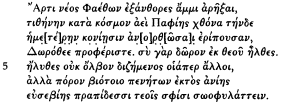
1 cf. 3,37 3 cf. 2,24s 4 cf. 6,4 5s cf. 5,18s
[66] Cf. M. Malinine, "Les noms de parenté en copte," GLECS 6 (1951–1954) 73–75.
Just now you have flowered forth like a new Phaethon to help us, to set upright and adorn this Aphrodito land of ours that nurtured us, though she had been thrown down in the dust, O excellent Dorotheos. For truly you come as a "gift from God." You have not come like others, seeking to get rich, but seeking a means of living for the poor, freed from grief, to keep your own people safe by your own understanding of piety.
1. On

4. The poem is really an extended pun (as is H19, Hypatius the hypatos ).
7. The second of the twin pillars of good administration of the city is

H15. Birthday poem for Constantine. P.Cair.Masp. I 67120 v D
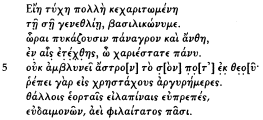
3 de composito cf. 2,22 3s cf. 25,3 5 cf. 17,12 6
=|= 'saeculum aureum' 7
May there be great good fortune, full of grace, on your birthday, O imperially named. The Hours and flowers overshadowed the whole place where you were born, O most graced one. Your God-given star will not become dim, for the silver portion has inclined to good. May you rejoice, as befits you, in feasts and solemn banquets, happy and beloved by all.
1-3. The overtones of


2. The name Constantine retains its associations as the name of the first great Christian emperor.
5. Here is the Christian Late Antique notion of a star attached to a particular person, under God's dispensation;[67] cf. P. R. L. Brown, The cult of the saints (Chicago 1981) 73. In the Life of Theodore of Sykeon (ed. A.-J.
[67] Dioscorus very likely knew the work of Paul of Alexandria and the related astrological writers from Egypt, traditional home of star lore; see W. Gundel and H. G. Gundel, Astrologumena: Die astrologische Literatur in der Antike und ihre Geschichte (Wiesbaden 1966) 236–254.
Festugière, SH 48, Brussels 1970) 4.6–7, we meet the idea of the star as a royal portent, and associated with the individual at birth.
6. Not as in Heitsch's note, but rather another allusion to the Neoplatonic doctrine of affinity, according to which like gravitates toward like; as in H21.6; Philoponus in De Gen. et. Corr. 218.17–20. On scales and weighing, see the study of E. Livrea in Studia Cercidei (Bonn 1986) 13, 44–48.
Constantine is not mentioned as one of the relations of Callinicus, Colluthus, Dorotheos, and Mark; but his poem is included in the same papyrus and must date from the same time in Dioscorus's production of occasional verse at Antinoë. The group continues with the next two poems.
H16. Birthday poem for an unnamed recipient. P.Cair.Masp. I 67120 v E

2
Ma |:cf. 17,9 3
Yesterday you raised up joy for your friends: today (you raise up) the joyful garlands of your victory. Divine Providence in its ordaining of things has made preparation; do not fail to keep God's commandments with regard to the poor and strangers. May you live free from pain, well off, loving God's commandments.
1.

3. On


4–5. Again the dominical commandments (cf. line 6), as in H17.3 and H10.14–15. The poor and the guest are one's neighbor par excellence. Cf. Dt. 10:19; Jer. 2:23.
6.



H17. Encomium on Count Colluthus the pagarch, P.Cair.Masp. I 67120 v F son of Apa Dios.

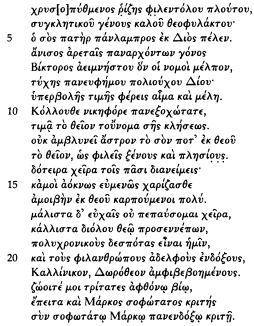
1 cf. 10 B 5 |
supra5 cf. titulum 6 de composito cf. 2,22 9: cf. 16,2 11. 12 cf. 15,5 13 cf. 10,14 15proin margine dextro 16etin m. dextro 17 deum invocantis est manus tollere 18in m. dextro 20ss cf. 13,20s 23s alter versus delendus
Most excellent in mind of officials, of senators and those who observe good judgment, of wealthy ancestry, with golden roots, loving God's commandments, of a fair senatorial house, guarded by God—your honored father came from God. You are a descendant unequaled in excellence of the high officials—Victor of everlasting memory, of whom poetry's numbers sing, and Dios, protector of cities, all-praiseworthy in his good fortune; you bear the blood and the repute of preëminent honor. O victorious and most highly exalted Colluthus, honor the divine name by which you are called. Your divine and God-given star will not become dim, because you love strangers and your neighbor. You hold out a giving hand to all; do not hesitate kindly to grant me the recompense from God I have fully earned. I shall not cease to lift up my hands in prayer, always addressing eloquent words to God, that my lords live long, they and their honorable and generous brothers, renowned Callinicus and Dorotheos. In the third place after them may you live a life free from envy, together with Mark, the most learned judge (together with learned Mark, the famous judge).
In this poem Dioscorus knits together many of the motifs he has used in other verses addressed to members of this family (cf. H13–H16).
1–4. These lines give a vivid description of just what a decurial official of a Late Roman city should be: intelligent, nobly born, pious, and of course generous—"of a fair, God-guarded senatorial house" like that of Hestia Polyolbos.


3. Underlying his use of this concept (cf. H5.40), did Dioscorus know of such Neoplatonic tradita as Proclus's comments on Hesiod's age of gold? (Cf. N. G. Wilson, Scholars of Byzantium [Baltimore 1983] 39.) The objects of his praise have "laid up treasures in heaven," being

On the combination of golden ancestry and pious wealth, cf. also line 9,

5. Note the pun on

7–8. Victor and Apa Dios cannot be exactly identified from the papyri. Cf. P.Cair.Masp. III 67279.14 and 24.
11. Again a reference to S. Colluthus, the patron saint of Antinoë (H13).
12–13. Here the personal star (cf. H15.5, and W. Gundel and H. G. Gundel, Astrologumena [Wiesbaden 1966] 236–244) is juxtaposed with the dominical precepts (

To Colluthus. P.Cair.Masp. II 67187.
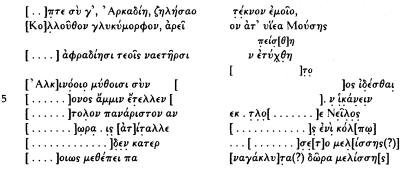
The first nine lines preserved on the horizontal-fibers side of this papyrus, even more fragmentary today than in Maspero's time, contain the remains of verses apparently belonging to the Colluthus group, which will accordingly appear here. The remaining lines contain matter belonging to the Achilles-Polyxena ethopoiia (H26 and P.Cair.Masp. III 67353 v C), which will be considered later.
1. Apparently some sort of negative is to be restored, to give the sense "Do not you, Arcadia, envy my child, Colluthus the good-looking, warlike son of the Muse . . . " (Thebais loquitur ). On Arcadia, see J. G. Keenan, "The provincial administration of Egyptian Arcadia," Proc. XIV intl.congr. papyrol. (London 1975) 189–194, and Mus.Philol.Lond. 2 (1977) 193–202.
4. "Alcinous's stories," a long-winded tale that would take too long to relate; proverbial in rhetoric, as Maspero pointed out. Cf. K. Tümpel, "'

8–9. Cf. on H5.15. Not enough is left on the papyrus to support Maspero's restoration.
The next two poems may also be placed in the early part of Dioscorus's activity at Antinoë, as they have stylistic and prosopographical links with the epithalamium H24 and the encomium H5.
H7. Encomium on Domninus, P.Cair.Masp. III 67316
cancellarius on the prefectural staff.
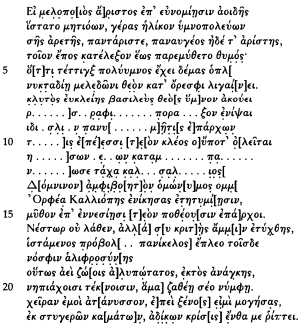
acrostichum:
. 5 cf. 5,15 9 cf. 2,1 10 cf. 1 verso 7,a [ leg. Ma 13Ma 17vel18 Hsch. s.v., cf. ad XXIX 63 19 cf. 2,12 20 cf. 2,30 21 cf. 3,24 22 cf. 5,19
If the best poet were to take a stand devising a song about good government, singing of honor in keeping with your excellence, O best of men, radiant with greatness, he would utter such a poem as to encourage my heart—like the songful cicada who has a chitinous body and sings in his nightly care even to the ears of God. Glorious God, the King of Glory, hears (my) hymn . . . craft of rulers . . . your glory will never perish . . . namesake of renowned Domninus. In truth you have outdone Orpheus son of Calliope, and nobles long to hear your story at their suggestion. Nestor was not without his fame; but you have arisen as a judge for us, standing as a bulwark; you are very like those (not) without good judgment. So may you live forever, without pain, free from need, with your little children and your divine wife. Stretch forth your hand to me, since I am a stranger and in distress, because of hateful troubles, where the judgment of the unjust has cast me.
1. The



5–6. Again the Christianized image of the pastoral cicada (cf. H5.15), combining Menander Rhetor's device of modesty with a Callimachean or Anacreontic topos while giving the whole a Christian twist:


7. An echo, conceptually, of Ps. 24:7–10 (which is sung in the Coptic liturgy for Easter Vigil). See R. W. Daniel, "Christian hymn: P.Vindob. G. 40195 and P.Ryl.Copt. 33," ZPE 42 (1981) 71–77, esp. 74. Dioscorus is reworking the whole allusion by using a pair of synonyms, punningly, for

13. Domninus cannot be exactly identified from the papyri; he appears to be the father of Paul (see following), the bridegroom of H24. The famous sixth-century Domninus was the city prefect at Constantinople in 566/7 (A. Cameron and A. Cameron, "The Cycle of Agathias," JHS 86 [1966] 21–22).
14. On the much-discussed figure of Orpheus in Late Antiquity, see A. Dupont-Sommer, ed., Le mythe d'Orphée aux animaux et ses prolongements au judaïsme, au christianisme et à l'Islam (Rome 1975). Compare the Coptic Museum reliefs (Zaloscer, Kunst im christlichen Ägypten, Taf. 18 and 23).[68]
[68] Also cf. Volbach, Elfenbeinarbeiten, nos. 96 and 70.
H20. Encomium on Paul son of Domninus, P.Cair.Masp. II 67185 v B
cancellarius on the prefectural staff.
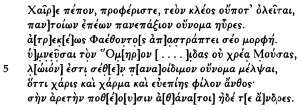
acrostichum:
.— 1 cf. 1 verso 7 2 cf. 4 b 9 3 cf. 1 verso 9 4sup. Ma e Nonn. D. 32,184, sed cf. 25,4 5 cf. Apollinar. Metaphr. 73,43 . . .5s cf. 1,5s 6s in marg. dextro scripti
Greetings, O bravest one, may your glory never fade; you bear a name worthy of eloquence of every kind. Truly your beauty flashes forth like that of Phaethon. I do not need Homer or the Muses to sing (of you); it is better (just) to hymn your name, renowned in song, as do Grace and Joy and the lovely flower of Eloquence; both men and gods long to see your excellence.
2. The name here is that of Saint Paul, the orator par excellence; cf. H. P. L'Orange, "Plotinus-Paul," in Likeness and icon: Selected studies, pp. 32–42. On the other hand, Chrysostom had regarded Paul as rather an unlettered, unskilled man whose rhetorical success was a miracle wrought by divine power and the intrinsic worth of the message he brought; Jean Chrysostome: Panégyriques de S. Paul (ed. A. Piédaguel, SC 300, Paris 1982) 202–209.
3. Did the figure of Phaethon also have a zodiacal connotation? See Nonnus's treatment of the myth in Dion. 38.90–434 for emphasis on his journey through the signs.
4. Dioscorus the doctus poeta, here altering his usual stance (cf. H14.1), is aware of Homer as the originator of rhetoric; Menander Rhetor 434.11 (ed. Russell and Wilson, with comment p. 347). On the Muses, cf. H12 B 3, H25.4, P.Cair.Masp. 67187.2, "der Musensohn."
6. Cf. H1.6, the encomium on Justin II; Dioscorus will also reuse the phrase



H11. Encomium on unnamed officials. P.Cair.Masp. III 67279 v
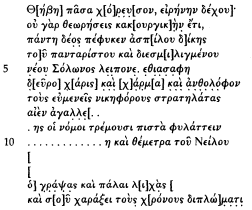
1–7 cf. 3,9–14 4 cf. 10,4 |
=, cf. Schwyzer I 160.209 10 cf. 3,6 13s cf. 5,38s |
Let the whole Thebaid dance and welcome peace, for you shall not behold evildoing any more; for fear of the spotless justice of the most excellent and polished new Solon has sprung up everywhere . . . Come, Grace and flower-crowned Joy, ever to honor the beneficent and victorious rulers . . . The laws stand in awe to guard (their) faithful judgments . . . and the sources of the Nile . . . May He who in ancient times wrote (the Tablets of the Law) write many years in your Book of Life.
3. Again


4.

5. Cf. H5.59, and H3.12, 30. Could Dioscorus have known of Solon and the Seven Sages from John Philoponus's comments on Aristotle's


6.

9. Cf. Nonnus Paraphr. 1.199, 4.172.
10. On the sources of the Nile, especially in Neoplatonic/Alexandrian commentary, see H13.3, with P.Turner 10. Nonnus's treatment of the "living water" in Jn. 4:10–14 (Paraphr. 4.43–69) has been linked to the Egyptian notion of the life-giving, Osirian Nile by R. Kuiper, 'De Nonno Evangelii
Johannei interprete," Mnemosyne 46 (1918) 246–247; cf. line 69, . . .


13.

H19. Encomium on Hypatius, P.Cair.Masp. II 67185 v A
excubitor on the prefectural staff.
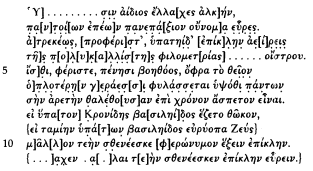
acrostichum:
.—2 cf. 4 B 9 4sup. Ma, 'poesis studio ardens' 8ss cf. 1 verso 2s 11sup. Ma
. . . You, O everlasting, have brought us help, and you bear a name most worthy of every sort of eloquence. Precisely speaking, Your Excellency, you bear a consular name, being "consul" in your love for poetry's beautiful numbers. Be a helper to the poor, O most brave, so God may guard from above with gifts of honor your young and thriving excellence for a countless time. If Zeus sat upon the consular seat of kingship (if far-seeing Zeus [established?] a housekeeper for kingship in the form of consuls), may God all the more be strong in keeping your name renowned. . . .
The title may also be restored as exceptor or possibly exactor (from

This poem is really an extended pun, playing on the recipient's name: lines 2–3, 8–9. For consuls in the Byzantine papyri, see R. S. Bagnall, A. Cameron, S. R. Schwartz, and K. A. Worp, Consuls of the Later Roman Empire (Atlanta, 1987) (cf. P.Cair.Masp. II 67178 v B 2).
4. No traces are any longer visible on the papyrus, but I should like to restore

H22. Epithalamium for Matthew. P.Lit.Lond. 99
+ P.Cair.Masp. II 67180
+ 67181

iustum ordinem versuum 1–7, quem supra legis, poeta litteris
significavit.— 1–3 cf. 21,1 4 cf. 21,3 5 cf. 24,9s 9 cf. 21,6 1119 cf. 21,14 21cf. LVI 39 21–23 cf. 23,17–20; 24,22
Bridegroom, may your wedding be filled with the dancing of the Graces, with gently nurtured roses, with honey-sweet grape clusters; you are marrying a bride who is an enviable Ariadne, and fittingly you have found her nobility of descent. Suddenly today a light has filled these our houses, because dear young Matthew has taken a bride. May you have the love of Wisdom, with Hera to bless your marriage; like gold you have found your golden bride, both of you like heroes, she ripe as a honeycomb. . . . Bridegroom, bend your mind to love; Zeus himself in heaven, because of Europa's beauty, is known to have become a bull; for love of Leda he was esteemed a swan. Carry your Europa over the threshold, not over the sea; go to bed with your Leda, but don't worry about wings. Even revered Apollo has felt the sting of sweet-darting love, for out of his love for Daphne Apollo is always known as god of the laurel. Take your
Daphne to wife, but she will not run away from you. Phoebus crafted many things, but he was not successful in love. You will not have long to wait until you see your dear children on your lap, prettily saying "Daddy," the lovely image of you and of their mother. This pleasant desire is worthy to follow your wedding.
1. Dioscorus used this line at the opening of Count Callinicus's epithalamium, H21.
4. Also borrowed from H21 is the Ariadne figure, an image appropriate both for a happy wedding and as a type of the soul united, after vicissitudes, to God.[69]
6. The image of light filling the houses echoes the scene in Nonnus Paraphrasis 3.3–8, Nicodemus's night visit to Christ, when "they went into the house, where there was a light," a scene painted like a de la Tour with one candle. Here the light is bright, for rejoicing; compare the figure of Phos in the Hestia Polyolbos tapestry at Dumbarton Oaks (Wessel, Koptische Kunst, pl. 132).
7. We cannot identify Matthew from the Antinoë/Aphrodito papyri; clearly he is not one of the coloni in P.Antin. III 201.
8. For


9. Here a slightly abbreviated version of Dioscorus's line alluding to the doctrine of affinity of like with like, as in H21.6.

10. For

12–19. Dioscorus here begins to adorn his epithalamia with classical images of the loves of the gods that are embodied in some of the best-known works of Coptic art: Europa and the Bull, Leda and the Swan, Apollo and Daphne.
12, 14. For Europa and the Bull, cf. the Coptic Museum relief, Zaloscer, Kunst im christlichen Ägypten, Taf. 14; and Volbach, Elfenbeinarbeiten, no. 82, the Trier ivory. The upper register of the Trier plaque contains a repre-
[69] Compare again the Ariadne on the Vienna textile (above n. 59), Wessel, Coptic art, pl. 113.
sentation of the Dioscuri, who are of course associated in myth with Leda (the next image in the poem). Was Dioscorus, in using these myths, at all conscious of making a kind of self-referent pun on the associations of his own name? (Cf. Hanfmann, "The continuity of classical art," in Weitzmann, Age of spirituality, pp. 89–90; and N. Leipen, "Classical tradition in early Christian art: A textile fragment in the Royal Ontario Museum,' in Studies in textile history in memory of H. B. Burnham, ed. V. Gervers [Toronto 1977] 168–177, on the Dioscuri.)[70] I have suggested elsewhere that Dioscorus's name may be a Hellenization of the name of the great Monophysite monk Shenoute ("son of God"), as well as an eponym of the great Monophysite culture hero, Patriarch Dioscorus I.[71]
13, 15. Two of perhaps the most famous works of Coptic art are the Leda and the Swan relief in the Coptic Museum and that in the Graeco-Roman Museum at Alexandria (Zaloscer, Kunst im christlichen Ägypten, Taf. 22, for the latter; Beckwith, Coptic sculpture, pl. 69, for the former; cf. also Beckwith, pl. 70, for another, fragmentary relief in Alexandria). These striking images have inspired speculation on Coptic sexuality since Strzygowski's Koptische Kunst (Vienna 1904) xvi, 33–35 (also in BSAAlex 5 [1902] 42–46). See Torp, "Leda Christiana," pp. 101–112. The position of J. Lauzière, "Le mythe de Léda dans l'art copte," BSAC 2 (1936) 38–46, might still be taken seriously.
These four artfully constructed lines, a pleasing transformation of a classical decorative conceit, amusingly contrast the loves of Olympian mythology, so omnipresent in the visual art of Dioscorus's period, with the realities of a sixth-century wedding (cf. the Projecta casket, combining the Toilet of Venus with vivatis in Christo ). The charming contrasts of




18–19. To illustrate Dioscorus's imagery, there are well-known Coptic representations of Daphne (cf. H27): in the Coptic Museum (Zaloscer, Kunst im christlichen Ägypten, Taf. 19 and 20) and in the Louvre (Beckwith, Coptic sculpture, pl. 61). The nymph is usually shown grasping two exuberantly twining branches of laurel that frame her figure.[72]
20. Note the play on


[70] Perhaps there are Egyptian associations with the very late Europa on the famous Veroli casket; see E. Simon, "Nonnos und das Elfenbeinkästchen aus Veroli," JbDAI 79 (1964) 279–336.
[71] L. S. B. MacCoull, "Dioscorus and the dukes," BS/EB 14 (1988).
[72] Compare also the Ravenna ivory, Volbach, Elfenbeinarbeiten, no. 80; and the "Shawl of Sabina" in the Louvre, (Weitzmann, Age of spirituality, no. 112), from Antinoë.
22. Cf. P.Cair.Masp. II 67179 r B (IV).
In this poem Dioscorus is quite closely following the prescriptions laid down by Menander Rhetor for an epithalamios logos (ed. Russell and Wilson, pp. 134–147, 309–323).
H23. Epithalamium for Isakios. P.Cair.Masp. III 67318
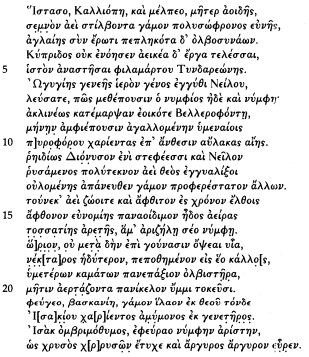
acrostichum:
.— 8 cf. 21,6 et 5,24 11s sententia contracta sed non corrupta esse videtur; cf. 3,42–44; 5,25–28; 10 B 2s; 21,8–10; 25,6–11 13(nomen subst.) = malum, cf.3,10 14 cf. 2,12 15excor. poeta 16 cf. 5,12 et 2,30 17–20 cf. 22,21–23 21 cf. 12,3 24 cf. 21,6 |delendum?
Come, Calliope, mother of song, and sing the ever-shining and solemn marriage of this couple who lie together in wisdom, filled with the blessings of splendor and love. He did not know how to do the matchless acts of Aphrodite, to set up the web of sinful Helen. Holy people of Theban descent on the banks of the Nile, look how the bridegroom and the bride are coming; to judge impartially, they have surpassed Bellerophon in likeness; they have surrounded the joyful moon with wedding songs, in the furrows of the grain-bearing earth that rejoice with flowers. Easily protecting garlanded Dionysus and the Nile with his many children, may
God grant a noble marriage free from the destructive envy of others. So may you live forever and reach a boundless length of life, exalting the renowned delight of good government, free from envy, and of such excellence, with your admirable wife. Soon you shall see children on your lap, sweeter than nectar, loved for their beauty—a blessing that your troubles have merited, as you do honor to the ability of your forebears. Go away, evil eye; this marriage is graced by God, this marriage of joyful Isakios, son of a famous father. Isakios, strong of spirit, you have found your noble bride, as gold has embraced gold and silver has found silver.
On the acrostic, with lines 22–23, there is no way to tell if this Isakios is the same person as the Isakios mentioned in P.Vat.Copti Doresse (see MacCoull, "Prosopography of Aphrodito," 91–94).
1. Cf. H7.14, on Calliope, mother of Orpheus.
3.Aglaia, splendor, cf. H12 B 5,

4. The subject of the verb is uncertain.
5.

6. Here Ogygia applies to Egyptian Thebes—a clever transference.
7. 
8. On Bellerophon, see comment on H24.11.
10.

11–12. The interwoven imagery of God, Dionysus and his train, and the old river god Nile is that of much of Coptic textile art. See Weitzmann, Age of spirituality, nos. 121, 123, 125, 136.
13.

21. On the Evil Eye, cf. comment on H12.3; and on Abaskantos, see L. Robert in Hellenica 26 (Rev. de philol. [1944] 41–42; Opera minora selecta III [Amsterdam 1969] 1407–1408).
24. Once more Dioscorus uses the doctrine of affinity as a simile for the couple's perfect union.
The group of the next three poems, H4, H9, and H28, is contained on the horizontal-fibers side of P.Cair.Masp. I 67097. The sale of land on the vertical-fibers side mentions a "present fifth indiction," which must be A.D.
571; while the receipts on the horizontal-fibers side mention a seventh and coming eighth indiction—A.D. 573/4. Hence, the poems must fall between these two dates.
H4. Encomium on Duke Athanasius. P.Cair.Masp. I 67097 v BC
(See Figure 9)
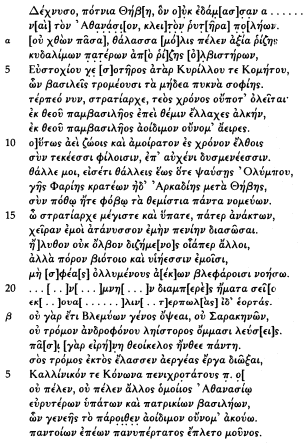
2 cf. 2,26 3 litteris a et b (v. infra) mutationes poeta significat; cf. ad 1 verso 2 | cf. 2,27 4 cf. 6,2; 13,4 7 cf. 1 verso 7 10 cf. 2,12 11 cf. 2,30 et 12 ,13 12 cf. 2,29; 12 B 9 13 cf. 2,2 16 cf. 3,24 |
supra17–19 cf. 6,24–26; 14,5s b3 cf. 5,32; 9,4 4supra,supra,post5supra6 cf. 2,3 7supra9 cf. 6,17; 12,14; 19,2; 20,2
Lady Thebes, welcome one whom . . . have not overcome, I mean Athanasius, the famous saver of cities. The whole earth and the sea are
hardly worthy of his family, sprung from renowned ancestors, from the stock of the blessed, Eustochius the savior and Cyril and Comes, before whom kings tremble as before the strong seed of wisdom. Rejoice now, Duke, your lifetime will never perish; you have got strength for justice from God, the King of all; from God the King of all you take your renowned name. So may you live forever and reach a boundless length of life, with your dear children, triumphing upon the necks of your enemies. Flourish and again flourish until you touch Heaven, ruling the land of Alexandria and Arcadia as well as the Thebaid, shepherding all your judgments in love and awe. O greatest and most high Duke, father of lords, stretch out your hand to me to relieve my poverty. I have not come like others, seeking riches, but seeking a means of living for my children as well, lest I see them with my eyes as they are perishing. . . . You shall not see the tribes of the Blemmyes or of the Saracens, nor shall you behold with your eyes fear of the destructive robber; for godlike peace has blossomed everywhere for all. Fear of you has kept the pernicious from having their way, namely that Callinicus and Conon oppress the poor. . . . Never, never was there anyone of far-famed consuls and noble kings like Athanasius, the famous name of whose ancestry I have long since heard. You alone are most highly exalted in eloquence of every kind.
1. Again Dioscorus personifies Lady Thebes; cf. H5.8, the encomium on Duke Callinicus; and HS10 r 9.
2. On Athanasius, cf. J. Maspero, "Etudes sur les papyrus d'Aphrodité, 2. Flavios Marianos, duc de Thébaïde," BIFAO 7 (1910) 97–119, and idem, "Les papyrus Beaug," BIFAO 10 (1912) 131–157, esp. 143; MacCoull, "Dioscorus and the dukes."
On the concept of "saving cities," cf. my comments on H10 B 6, and on H28.16.
3. Cf. HS10 r 14; Viljamaa, Greek encomiastic poetry, p. 52.
5. On Cyril and Comes, cf. H9.8. A Eustochius cannot be identified from the papyri or from PLRE II.
6. We are reminded of the extra overtones attaching to this word (

8–9. On

9. His full name (from P.Cair.Masp. I 67002.1) was Fl. Triadios Marianos Michael Gabriel Constantine Theodore Martyrios Julian Athanasius—an impressive list of heavenly patrons for a nobleman (cf. MacCoull, "Dioscorus and the dukes"); cf. b line 8.
13.

b1. See E. Livrea, ed., Blemyomachia (P.Berol. 5003) (Meisenheim am Glan 1978) 11–15; L. S. B. MacCoull and L. Koenen, "Papyrus fragments from the monastery of Phoebammon," Proc. XVI intl.congr.papyrol. (Chico, Calif. 1981) 491–498; R. T. Updegraff, "A study of the Blemmyes" (Diss., Brandeis University 1978). It would appear that the codex containing the Blemmyomachia poem came, not from "a tomb at Thebes (Livrea, p. 1), but from the monastery of Phoebammon, mentioned in P.Cair.Masp. III 67299.51, if this can be identified with the Theban house and not with one in the Antinoë area. On the campaign of Narses against the Blemmyes, under Justinian, cf. Livrea, p. 13 with n. 19 and the literature there cited. Antaeopolis had been sacked by the Blemmyes early in the sixth century, in connection with a notorious case of suspected paganism (Gnosticism?): P.Cair.Masp. I 67004.9 (petition to Duke Athanasius), cf. P.Cair.Masp. I 67009 x 18 (with Saracens on r 22). The inhabitants of the area could well hope for deliverance from a real threat.[73]
2, 4. For rhetoric along these lines, cf. P.Cair.Masp. I 67089 r B, analyzed by Bell, "An Egyptian village," pp. 27–28, esp. lines 6, 8–11.
5. Obviously this Callinicus is not the Duke praised by Dioscorus in H5 and elsewhere; this villain and his colleague Conon cannot be identified from the papyri but perhaps were extortionate pagarchs of a type with which Dioscorus was already all too familiar.
H9. Encomium on an unnamed duke P.Cair.Masp. I 67097 v D
of the Thebaid.
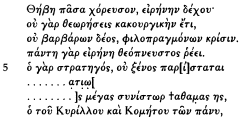
[73] Compare the testament (P.Cair.Masp. II 67151; see Chapter 3) in which the testator leaves money in his will to rescue prisoners of the Blemmyes; see H.-R. Hagemann, Die Stellung der Piae Causae nach justinianischem Rechte (Basel 1953) 65–70; R. T. Updegraff, "A study of the Blemmyes," (Diss., Brandeis University 1978) p. 152.
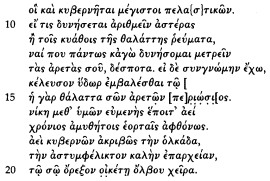
1s cf. 3,9s 4 cf. 4 b 3 7
? Keyd 10–13 cf. 5,43–46 13 andelendum? 15 cf. 2,27; 6,15 16 cf. Menand. Epitr. fr. 11 (616) 20 cf. 5,62
Let the whole Thebaid dance and welcome peace; for you shall not behold evildoing any more, nor the terror of the barbarians, nor the judgment of the corrupt. For God-inspired peace is shed abroad everywhere. For the Duke has come, not as a stranger. . . . you are the great sharer, inflexible (?), successor in every way to Cyril and Comes, who were the great captains of their clients. If someone could number the stars, or measure out the sea's waves with a spoon, then I could measure your excellence, my lord. If I have your leave, order the water to dash against . . . For the sea of your greatness is immense. May generous victory ever follow you, living long and in plenty amidst indescribable festivity. May you ever steer the ship of state aright, the beautiful unshakable eparchy, and stretch out your hand of blessing to one of your household.
3. Cf. the previous poem, H4, b 1–4. For

4.

5.




7. Maspero emended


8. The repeated reference to Cyril and Comes, plus the import of line 3, might incline one to think of Athanasius as the recipient of this poem as well.
9. Compare line 18, and P.Cair.Masp. I 67089 r B1. Dioscorus might possibly have known Plato's Phaedrus; could he have been aware of Alcaeus 208? Specifically for


"The great captains of their clients': for an old-fashioned view of patronage and clientage in Late Antique Egypt (as in Hardy, Large estates, pp. 22–24, and Rouillard, L'administration civile, 9–15, 182–184), see A. H. M. Jones, The Later Roman Empire (Norman, Okla. 1964) 775–781. Justinian's Edict 13 was much more concerned with the collection of the grain embole than with attempting to regulate the relations of patrons and clients. For a revised view of the oikos, see J. Gascou, "Les grands domaines, la cité et l'Etat en Egypte byzantine (5e , 6e , et 7e s.)," Trav.etMém. 9 (1985) 1–90. The "great house" provided the state with phoros, revenue. The best way to see this world is to read the documentary papyri (in both Greek and Coptic), not to construct theories about "feudalization."[76]
Patronage in Late Antique Egypt is a subject that requires thorough reexamination. In such an agrarian realm, the individual producer's relation to each of four loci of power must be evaluated: to the central government, to the patron or landlord, to the church, and to the kindred. The areas of these four circles overlap in complex ways.
What was principally emphasized in earlier approaches to the subject was the double aspect of "privatization": first, the growth of a colonate in which immobility, attachment to the land, was originally a prime determinant, and the subsequent growth of a new definition of the social condition of the person; and second, the assumption by landowners of functions previously thought of as belonging to the imperial government at Constantinople and its agents. Every agricultural producer in Egypt grew some grain that went to feed the capital city, via the aisia embole, the "auspicious" embole or annual shipment. (Modern critics have seen the epithet as ironic; but Dioscorus, who used it often, took it directly from the text of Justinian's Edict 13:4.1, and the classically educated chancery writers were not being ironic.) The collection and shipment of this grain was seen to at the most basic local level; hence, the importance, where it existed, of the right of autopragia, or self-responsible collection, and the freedom from being col-
[76] See now P. Crone, Roman, provincial, and Islamic law (Cambridge, England, 1987); cf. L. S. B. MacCoull, "Notes on the social structure of late antique Aphrodito," BSAC 26 (1984) 73–75 with n. 21.
lected from twice over by the (imperial) pagarch. How farmer-producers became "clients" as opposed to, or as well as, simply tenants, renters, is the question.
Scholars have begun examining patronage with the term coloni adscripticii in the law codes; its Greek calque,

Churches and monasteries also functioned as landlords, especially through the medium of the heritable land lease or emphyteusis, with its provisions for improvement of the property (paralleling the entrepreneurial activities of estate clients who improved their lands with subcontracted labor). And underlying every other economic relationship in Egypt was the inescapable bond of physical kinship. The Christianization of Egypt had involved an effort to cut across the ties of the stiflingly close Egyptian extended family by substituting other ties, e.g., those of anachoresis and the "monastic family." By the sixth century, we see the conflicting claims of these two centers of power (e.g., the case of the novices Anoup and Julius, Chapter 2). In Late Antique Egypt, it was conceivably possible to be in the
[77] Extremely helpful is the work of J.-M. Carrié, "Figures du 'colonat' dans les papyrus d'Egypte: lexique, contextes," Atti XVII congr.intl.papirol. (Naples 1984) 939–948, and his own work and the literature cited p. 939 n. 1. See also J. G. Keenan, "On law and society in Byzantine Egypt," ZPE 17 (1975) 237–250, and his study of social mobility in Egypt to appear in ANRW; also MacCoull, "Patronage and the social order in Coptic Egypt," Egitto e storia antica (conference, Bologna, September 1987).
[78] See the list of enapographoi up to that time by J. G. Keenan, "The names Flavius and Aurelius as status designations," ZPE 11 (1973) 55–56, n. 96. They seem to be involved in transactions of renting irrigation machinery and of surety; idem, "On P.Oxy. XXVII 2479," ZPE 38 (1980) 246–248 (cf., in Coptic, P. Berol. 11349 in Chapter 2: hire of a mechane and field damage by unruly animals).
[79] Oikos and phoros are elucidated by Gascou, "Les grands domaines, la cité et l'Etat en Egypte byzantine (5 , 6 , et 7 s.)," Trav.etMém. 9 (Paris 1985) 1–90. One hears this phenomenon attested to even today: "That man belongs to one of my villages," a Coptic nobleman will say.
position of owing an obligation—financial, social, or both—to your uncle the monastic oikonomos, who was simultaneously the collector of your farm's rent and the accountant of the grain collection for that indiction.
10. As well as using this as a poetic cliché (as in H5.43), Dioscorus is possibly also alluding to Gen. 15:5 (and Hebr. 11:12), on the seed of Abraham.
17. Cf. the remarks of J. G. Keenan on the yearly calendar of Aphrodito and Antinoë (in an article to appear)—the recurring round of ecclesiastical and secular festivity that shaped one's world.
18. On the "ship of state" (Pl. Rep. 488A–E; Arist. Polit. 1276B), cf. Cod.Just. III.1 14.1; Theodoret De prov. 2, 7 (PG 83.576AB, 676B–D). As Dioscorus calls the ship

19.

H28. Anacreontic. P.Cair.Masp. I 67097 v F
(See Figure 10)
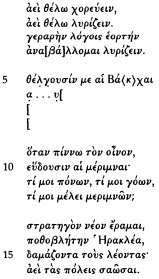
carmina Anacreontei generis; cf. Cr l.c. 664–66.— 1
supra| cf. Anacreont. 49,10 (R)2 post 2 et 4 bini versus
excidisse videntur 5 leg. Cr 9–12 = Anacreont. 45,1–4 12
14coni. Ma
I want always to dance, I want always to play the lyre. I strike up my lyre to praise the solemn festival with my words. The Bacchae have cast a spell on me. . . . When I drink wine, my cares go to sleep. What do I care for pains and groans, what do I care for troubles? I love a young soldier, a Herakles with longing eyes, a lion tamer; ever one to save our cities.
For comments on this poem, see MacCoull, "Dioscorus and the dukes."
One can almost see what Dioscorus's young soldier would have looked like: a figure in cataphract's mail, with the great dark eyes of an encaustic portrait. This sixth-century skolion is unique in its way, using the universal form of the drinking song (beginning with a straight classical borrowing) to voice some of the deepest concerns of Byzantine Egyptian society. If the verse as we have it was ever actually sung, its background would have been one of the opulence necessary to the concept of the noble life as lived by Coptic dynatoi: a summer palace or great villa, an Egyptian equivalent of Qusayr Amrah. The patronage feasts of the great families of Antinoë (and Aphrodito, and Oxyrhynchus) must have taken place in appropriate architectural surroundings (unfortunately not yet discovered by excavation), accompanied by the Greek and Coptic equivalent of the lost art of the Sasanian court dinner minstrels. It is telling that the most important deed for which the

Dioscorus's source is Anacreontea 45 (ed. K. Preisendanz, Teubner, Leipzig 1912), with echoes of 38 and 39. The parallels are laid out by Crönert in Gnomon 2 (1926) 664–666.[80] Th. Nissen, Die byzantinischen Anakreonteen (SB. Bayer.Akad.d.Wiss., Munich 1940) treats George Grammaticus and Sophronius, but does not mention Dioscorus (but cf. p. 16 on the name Colluthus, so characteristic of the Antinoë region).
It has often been noticed that Dioscorus's Greek-Coptic glossary (H. I. Bell and W. E. Crum, "A Greek-Coptic glossary," Aegyptus 6 [1925] 177–226)
[80] See B. Baldwin, "Dioscorus of Aphrodito and the Anacreontea," Museum Philologicum Londiniense 8 (1987) 13–14.
contains many words for wine and drinking-song terminology, most famously (P.Lond. V 1674v = 1821) lines 250–252 '


5. For

14. On

The Herakles figure in Coptic art (cf. M. Simon, Hercule et le christianisme [Paris and Strasbourg 1955]) is a well-known one, especially assimilable to the figure(s) of David or Samson wrestling with lions. Examples are the Coptic Museum frieze (Zaloscer, Kunst im christlichen Agypten, Taf. 52, 54); the Brooklyn Museum textile and bronze;[81] and the Sheikh Zoueide mosaic (E. Bernand, Inscriptions métriques de l'Egypte grécoromaine [Paris 1969] no. 122). In Dioscorus's own poetry, cf. H21.23; H2.21. Cf. Bernand no. 82.2 (4th c.):

Also contained in P.Cair.Masp. I 67097v (below fr. F) is Dioscorus's chairetismos addressed to the emperor Justin II; for a full text and commentary, see L. S. B. MacCoull, "The imperial chairetismos of Dioscorus of Aphrodito," JARCE 18 (1981, appeared 1984) 43–46.
The following seven poems bear no evidence of their dates, either internal or external. They are assumed to belong to Dioscorus's Antinoë period, sometime between A.D. 566 and 573.
Poem on a monastic profession. P.Cair.Masp. II 67182
(See Figure 10)
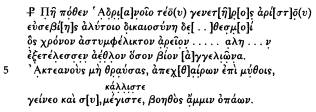
[81] Textiles: D. Thompson, Coptic textiles in the Brooklyn Museum (Brooklyn 1971) no. 22 (pp. 54–55); bronze: Brooklyn Museum, Late Egyptian and Coptic art (Brooklyn 1943) pl. 25.
How and whence, from Hadrian, your excellent father, came justice and the bonds of indissoluble piety, (for you) who (go to) a better, an unshakable life, having achieved such a prize as the angelic life? Without ruining the poor, as your enemies might say, may you too, O greatest (fairest) one, become a helper and comrade to us.
This poem celebrates the entrance of a young man of Antinoë into the monastic life.
1. It is uncertain whether "Hadrian" is actually the aspirant's father's name or is a poetic way of designating, as forebear, the founder of Antinoë. For Hadrians at Antinoë/Aphrodito, cf. Hadrian son of Abraham, soldier, originally from Antaeopolis, in P.Lond. V 1671.5, 1844, P.Flor. III 280.12, P.Cair.Masp. I 67052.4, a contemporary of Dioscorus's father Apollos; Hadrian the priest, P.Flor. III 297.315 (cf. Abba Hadrian in SPP XX 248.3, from Antinoë); Hadrian the goldsmith, P.Flor. III 297.126. A Count Hadrian is mentioned in PSI VII 836.3 (no provenance); P.Lond. V 1761 is from the Hermopolite, while 1788 and 1802 also have no provenance. In SB I 1896, one Konnos son of Hadrian inscribed his name in the Valley of the Kings, at an unknown date. Could this "son of Hadrian" be thus a contemporary of Dioscorus himself, entering a monastery in his forties?
2. Cf. H6.6 (where


3. Cf. H9.19 and Nonnus Paraphr. 3.84, 10.1, 18.48. Robert was wrong (Comptes rendus de l'Académie de Belles-Lettres [1971] 597–619) to state that this word is never used in a Christian context.
4. The classic locution for the monastic life is of course the






5. Perhaps a reference to the criticism of anachoresis as a way of evading civic and patronal responsibilities; see Brown, Making of late antiquity, pp. 85–86, 93–94. (Could there have been an Egyptian Rutilius Namatianus? Zosimus puns in derogatory fashion on notions of "poverty" in his antimonk remarks in Hist.nov. 5.23.)
6. An allusion to the "second birth" of monastic profession, and to the role of the ascetic as friend and intercessor.
On entrances into the monastic life at Aphrodito/Antinoë, see the Coptic transactions written by Dioscorus in P.Cair.Masp. II 67176r, published in L. S. B. MacCoull, "A Coptic cession of land by Dioscurus of Aphrodito," II intl. congr. coptic studies (Rome 1985) 159–166; and P.Cair. Masp. III 67353r, reproduced in Chapter 2. These transactions record a cession of land and an arbitration made by the family of Julius son of Sarapammon, Anoup son of Apollo, and their mother Mesiane, before the two men enter the monastic life at Dioscorus's family's second house, the monastery of Pharoou. (Cf. M. Krause, "Zur Möglichkeit von Besitz im apotaktischen Mönchtum Ägyptens," II intl.congr.copt.stud. [Rome 1985] 121–134.) Could this poem have conceivably been addressed to either Anoup or Julius? The cession in 67176 is dated 28 October 569; the verso (with an apokeryxis draft) of 67353 is dated 12 November 569. No sure identification can, however, be made.
Encomium (epithalamium?) on Zacharias P.Cair.Masp. II 67184
the silentiarius.
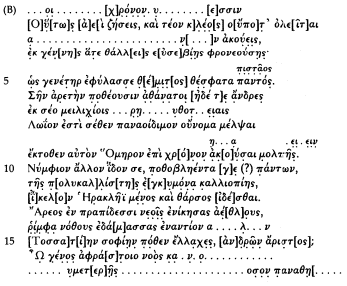
Verso.

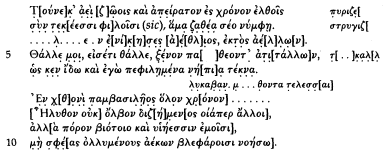
So may you live forever, and your glory shall never fade. . . . just as you flourish, being from a stock that bears piety in mind; as your father guarded the divine decrees of right and faith. Gods and men long for your excellence, from you in gracious . . . It is better to sing your all-praiseworthy name, let alone to hear Homer himself for a time of song. I have seen you as another bridegroom, looked at with longing by everyone, big with the loveliness of a most beautiful voice, resembling Herakles in strength and bold to look upon. You have surpassed the combats of Ares in your most recent deeds, having quickly vanquished the bastards. . . . Whence have you got such great wisdom, O best of men? O descendant of inexpressible . . . of like-minded nobility. So may you live forever and reach a boundless length of life, with your dear children and your divine wife. . . . Running for the prize, you have won, free from storms. Flourish and again flourish, cherishing the stranger, so I too may see my dear little children. (Having) spent a whole year in the land of the Emperor, I have come, not like others, seeking riches, but rather seeking a livelihood for my sons, lest I see them with my own eyes when they are perishing.
The papyrus originally bore a list of the names of the four Aphroditans who went to Constantinople in 551: Dioscorus, Senouthos (representing Kyros), Apollos, and Callinicus. Dioscorus seems to have kept the papyrus and reused it for poetic work fairly soon after his return. Cf. P.Cair.Masp. I 67032.9–14.
5.

Read Dioscorus's own correction,


This verse proclaims once again that defense of the faith is the first job of a late Roman official and the prime ornament of a family tree.
6ff. Crönert in Gnomon 2 (1926) 659–660 noticed the acrostic of silentiarius, and connected it with the

9. Dioscorus's praise of Homer; cf. H20.4; H12 B 4.
10.

14. Who "the bastards" may have been is not known.
16. Cf. H6.1.
v7. If this line refers to Dioscorus's trip to Constantinople, perhaps the poem might thus be dated early, to soon after his return and possibly before his move to Antinoë. But the allusion is not a specific one.
Birthday poem. P.Cair.Masp. II 67178
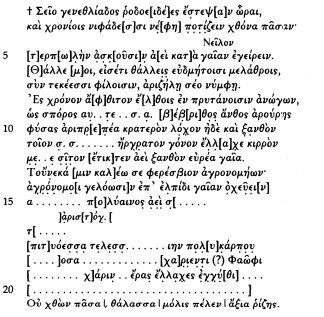
B
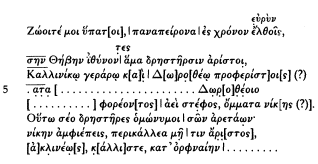
The rosy Hours crowned your birthday, and the clouds watered the whole earth with timely showers; they practice ever to arouse delight along the Nile (throughout the land). Flourish and again flourish in your well-built halls, with your dear children and your admirable wife. May you reach an imperishable time, giving commands among the councilors, like seed heavy with . . ., the flower of the field, having brought forth a
splendid, strong, fair-haired offspring; like the . . . has got tawny fruit, (so) the wide earth has always given birth to the fair grain. Wherefore I call you the farmers' lifesaver: the farmers laugh with hope to make their land fertile . . . ever much-praised . . . pine-wooded . . . rich in crops . . . in smiling Phaophi. . . . The whole earth and the sea are hardly worthy of your noble descent. Long live the consulares; may you reach an all-boundless length of life, guiding your Thebaid aright, together with your excellent co-workers, old Callinicus and Dorotheos, the outstanding ones, . . . ever bearing the crown, the eyes of victory. So your colleagues are named like their virtues: you keep company with Victory, the beautiful skill of the best (?), and, fairest one, you unswervingly (hold fast?) against the darkness . . . .
3. Cf. H25.3.
4. A literary reference, literally true only in the coastal strip of Egypt and parts of the Delta, but reminiscent of Ps. 64:10–12.
5. The Nile Flood, triggered by the rains in Abyssinia; cf. H10 B 1, the inundation.
8. Cf. H17.1–2 with comments.
9. An echo of Ps. 64:14, with Cant. 2:1.
10–12.


13.

18. As the wine harvest usually took place in Thoth (September), Phaophi (October) marked the beginning of pressing the grapes for wine making—a pleasing image.
B1. In Dioscorus's poetry, cf. H4.3, and HS10 r 14.
2. On consulares, see now R. S. Bagnall, A. Cameron, S. R. Schwartz, and K. A. Worp, Consuls of the Later Roman Empire (Atlanta 1987).
4. The mention of Callinicus and Dorotheos ties this poem together with H21, H5, H13, H14, and H17. As Callinicus is called

6.

8. Perhaps restore

9. A verb with the meaning "oppose" must have been lost here. A poignant foreshadowing of what was to happen to the polite culture of Dioscorus's world after the catastrophe of 641 and its aftermath.
The games of ancient Greece. P.Cair.Masp. II 67188.6–10


Four games there were in Hellas, four sacred events: two of men, two of gods. They were (the games) of Zeus, of Apollo, of Palaemon, and of Archemoros. Their prizes were the wild olive, the bay, the wild celery, and the pine: the Olympian, Pythian, Isthmian, and Nemean games.
9. For pine as the Nemean garland, and the rest, cf. Plutarch Quaest. Conviv. 676F; Euphorion, fr. 84 (Powell and B. A. Van Groningen, Euphorion [Amsterdam 1977] 153–156); Callimachus fr. 59 (Pfeiffer). An interesting witness to Dioscorus's knowledge of Hellenistic poetry.
10. The games are mentioned in the official, traditional order. The names of the tutelary god or hero and of the prize also occur in the same, corresponding order.
Dioscorus may have been prompted to compose this epigram, not only as a classical mnemonic, but also by awareness that the Olympian Games had been celebrated at Antioch as recently as A.D. 507 (and the circumstances of their cancellation in A.D. 520; Malalas 396.4–9, and esp. 417.5–8). Dating by Olympiads continued to be used in the work of Monophysite historians: the Chronicon Paschale, Jacob of Edessa, Elias of Nisibis, and even Michael the Syrian and the Armenian Samuel of Ani (cf. V. G:rumel, La chronologie [Paris 1958] 211–212). Could Dioscorus also have been inspired by a small self-referent pun, inasmuch as the Dioscuri were presidents of the Olympic Games (Pind. Ol. 3.35; D. L. Page, Further Greek epigrams [Cambridge 1981] 35)?
Encomium? P.Cair.Masp. III 67338

This papyrus is not, even today, quite so damaged as Maspero made it out to be. After the line beginning


and after the line beginning


There are traces of one line above '


[Fold line]

As Maspero noticed, the reference is to the eponymous hero of Antaeopolis. (Cf. the Antaeus statue in the Cairo Museum: J. G. Milne, A history of Egypt under Roman rule3 [London 1924] 243.) Antaeus had probably been identified with some form of ancient Egyptian divinity (Wernicke in RE I.2340, citing ZÄS 20 [1882] 135ff.).

Maspero also assumed that the Senouthos mentioned by Dioscorus as titulary of a monastery is the great Shenoute of Atripe; I see no reason to doubt this. The monastery of Apa Saborios (Sabouerios) at Aphrodito is known also from P.Cair.Masp. I 67002 III 20; 67080.6. "You have settled limitless gold upon the monasteries of Shenoute and Saborios" appears to be praise for a local donor.
The third fragment is the least clear.



How this poem coheres is still to be explained. Perhaps Dioscorus was praising a magnate of Antaeopolis whose distinguished piety was manifested in large donations to (non-Chalcedonian) monastic foundations.
H27. Ethopoiia on Apollo with P.Cair.Masp. II 67188v
Hyacinthus and Daphne


versus restit. Cr I.c. 658s. 2
leg. Ma,coni. Cr 3coni. Cr 5 cf. Nonn. D. 47,446
To you, Hyacinth, and you, lady Daphne, hope of my heart, many greetings. Apollo too stands between you, grown into a plant, so I too may be with you without doing you harm. What more could I want, what more could I imagine than Hyacinth at my right, and Daphne on my left?
On Apollo and Daphne in Dioscorus's poetry, cf. H22.18–19, with the visual parallels there cited, including the "Shawl of Sabina" in the Louvre and the Coptic Museum and Louvre reliefs. In fact, this piece sounds like an ekphrasis of a work of art, one unlike the Ravenna ivory (Volbach, Elfenbeinarbeiten, no. 80) showing Apollo with only one of his loves, but a symmetrical composition depicting the god between two plants, the hyacinth and the laurel. For such a composition in Nonnus, see W. Fauth, Eidos poikilon: Zur Thematik der Metamorphose u. zum Prinzip der Wandlung aus dem Gegensatz in den Dionysiaka des Nonnos von Panopolis (Hypomnemata 66) (Göttingen 1981) 18, cf. 144–157. Compare also George Grammaticus Anacr. 4 (ed. T. Bergk, Leipzig 1878). For the Christianization of the Daphne myth, see Torp, "Leda Christiana," 103.
3.

In the back of Dioscorus's mind may also have been a pun on the name of his father Apollos. Perhaps such a work of art adorned the walls of the house in which Dioscorus grew up in Aphrodito.
H26. Ethopoiia on Achilles and Polyxena. P.Cair.Masp. III 67316v
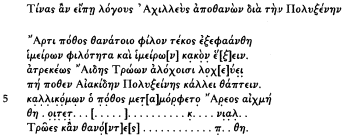
ad argumentum cf. XXVI, XXXVII et Cr l.c. 658.— 1 post
aut postinterpungendum 3 cf. Hsch. s.v.
Just now the longing for death, my child, sprang up in me, dearest of dreams and worst of dreams at once. Surely it is Death that has quickened the Trojans' wives, how to bury Achilles because of Polyxena's beauty. The fair-haired ones' longing has been transformed by the spearpoint of War . . .
On this subject, cf. Heitsch XXXVII, P.Flor. 390 (fifth century?), and, in Dioscorus's own work, P.Cair.Masp. II 67187.10–18 (below); cf. P.Cair.Masp. III 67353 v C, preserving only the title, not the text, of an ethopoiia entitled "What Achilles would have said when asking Thetis for his armor." Last words were a favorite form of school exercise, especially those of a mythological character. Dioscorus probably learned the Achilles-Polyxena story from Quintus Smyrnaeus 14.213–215, 240–241, 257–328, and he very likely knew the work of his countryman Triphiodorus (403–404; 686–687). The love story of the hero and the Trojan girl is related by Malalas, 130.6–131.21, including Achilles' death scene.
1. On


3. Note the play on words.
5. Dioscorus will reuse '́


In P.Cair.Masp. II 67187.10–18, after the encomium on Colluthus, Dioscorus also treated this subject. The text follows.

(What) the death of Achilles and (the sacrifice) of Polyxena (would have meant?) to the Trojans . . . The goddesses are helpers to the Trojans . . . another the same as Achilles . . . shatter the ill-fated city, (filled?) with corpses . . . (Death?) has taken the ever-wandering, longed-for, strong one . . . here with wrought shields . . . raising up the walls with (his) hands. Come and build on a peak the tomb that shall be visible everywhere, so that the lamentable doom of Achilles may be imperishable.
12. Cf. Pamprepius 4.39–40, on Miltiades.
16. Maspero cited Nonnus Dion. 47.679 as a parallel to the end of the line.
It may be that Dioscorus had yet another poetic model. His countryman, Christodorus of Coptos, had written an ekphrasis on the classical statues in the gymnasium of Zeuxippus at Constantinople (AP II). The works of art no longer existed after the fire of A.D. 532, so Dioscorus could not have seen them during his trip to the capital in 551; but in the world of late Egyptian poets, he might well have read Christodorus's work either before or after his journey. Lines 196–205 are part of an epigram (the whole is AP II.192–208) on two adjoining statues of Pyrrhus and Polyxena. Dioscorus was hardly at a loss for examples to draw on for the Death of Achilles/Polyxena story. Christodorus may have been one more of them.
Heitsch II S 10. Encomium on an unnamed P.Berol. 9799
Thebaid.
recto
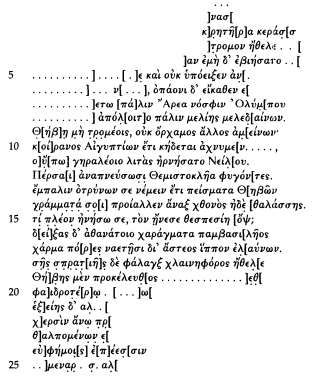
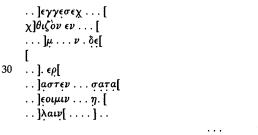
verso
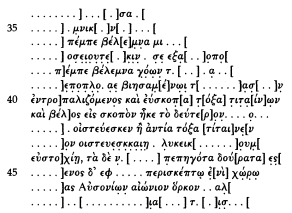
(vacat)
. . . having mixed a wine cup . . . wished . . . my . . . was overpowered . . . and did not give way . . . yielded to his comrade . . . Ares again far from Olympus . . . again perished, though he had a care for his spear. . . . Fear not, Thebes, there is no better leader; the chief of the Egyptians still cares for those in trouble. Nor shall he deny the pleas of old Nile. (Even) the Persians stop for breath fleeing from (this) Themistocles. Rousing you for your part to manage the stays of the Thebaid, the lord of earth and sea has sent out a letter to you. How shall I further praise you, whom the divine voice has praised? You have received the inscriptions of the immortal King of all, and you have bestowed joy on the inhabitants as you drive your horse through the city. The mantle-wearing phalanx of your army has wished to . . . the forerunner of Thebes. . . . more radiant . . . in order . . . with lifted hands . . . warm . . . in pleasing words . . . yesterday's . . . throw javelins . . . (who) keeps turning round and drawing his unerringly aimed bow . . . and he sent a second missile at the target . . . shot arrows or drew opposing bows . . . by good aim . . . firmly planted spears . . . in the admired land . . . the eternal oath of the Latins . . .
In the matter of attributing this work to Dioscorus, I am grateful to Dr. G. Poethke of the Staatliche Museen zu Berlin (DDR) for a photograph of the papyrus.
7. On Ares in Coptic art, cf. e.g., the seated Ares at Dumbarton Oaks (Beckwith, Coptic sculpture, pl. 17).
9.


10. Cf. H2.1; H1 r 17, v 2–3. Cf. H3.77 for a fuller treatment of this idea. Read

11. Again the personification of the river god, as in H5.25–26 and elsewhere.
12. An amusing reworking of a theme from classical history. The duke of the Thebaid is being compared with Themistocles, the defender of Athens at Salamis. (Had Dioscorus read Thucydides at school? Or was such an expression proverbial?) Could the reference be to Justin II's defense of the Armenians in his correspondence with Khusrow of Persia? (F. Dölger, Regesten der Kaiserurkunden des oströmischen Reiches [Munich and Berlin 1924], Justinos II nos. 22–23, citing Michael the Syrian [10.1; 2.282–283]).
13.

14. The phrase



15. On


16. Here

17. A vivid picture of the duke's adventus in his official carriage.
18. Read

19. For

22. In a note on H17.17, Heitsch noted the parallel with the orantes on Coptic stelae.
46. An unusual phrase, in which we see Dioscorus's lawyer's mind at work. For the

Trinity and the victory of Justinian; 67243 B 18–19, by the Trinity and




This collection of verses is an odd assortment; it seems to be an encomium of a type perfectly well known from Dioscorus's pen (lines 9 to perhaps 27), sandwiched in between two lots of scrappy Homeric battle narrations (lines 1–8 and roughly 28–47). Are the Homeric combats intended to describe the duke's own campaigns? The first and last thirds of the papyrus are too fragmentary to reconstruct such a coherence.
Dioscorus returned from Antinoë to Aphrodito in A.D. 573 (P.Cair. Masp. I 67096 [cf. P. J. Sijpesteijn and K. A. Worp, "Chronological notes," ZPE 26 (1977) 279], I 67121). Back in his native town, he composed his last two preserved poems, both addressed to John, duke of the Thebaid from 573–576: the first, more of a sketch or overture; the second, his longest and grandest work. These two final poems recapitulate the themes and weave together all the threads of Dioscorus's contribution to the literature of his society.
H2. Encomium on Duke John. P.Cair.Masp. I 67055 v
A.D. 574–576.
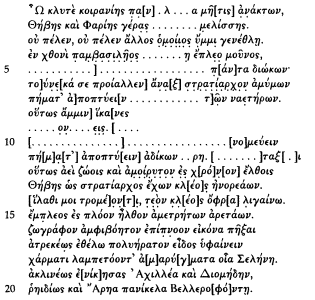
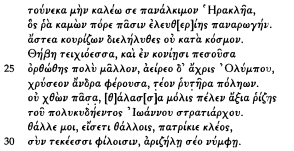
1 cf. 5,13; 6,16; 13,7 2 cf. 4,13; 5,30 |
, cf. ad 1 verso 2 3 cf. 3,39; 4 b 6; 5,6; 6,9; 13,5; Nonn. Met. i 52 4 cf. 3,40; 5,4; 6,23; 13,6; 4 b 9 6s cf. 5,7s 7 cf. 11; 3,82s 7s et 11s variationes? cf. ad 1 verso 2 8 cf. 3,46; 5,18; 13,11 12=? cf. 4,10; 5,3; 13,18; 23,14 14s cf. 5,14; 21,24s 15 cf. 5,5 16–20 cf. 5,20–24; 21,17–19.22s; acrostichumcognov. Cr 19 cf. 3,48 20 cf. 24,11 21s cf. 5,9s |22 de composito () cf. 13,3.17; 15,3; 17,6 23 cf. 3,38 | cf. 1,10 24s cf. 14,3 (3,58) 25 cf. 12B 9 27 cf. 4,3 29 cf. 4,12; 5,3; 12B 9 |semper P30 cf. 3,52; 4,11; 13,19; 23,16; Nonn. D. 2,594; passim
O renowned . . . of sovereignty, craft of rulers, honor of the Thebaid and Alexandria . . . Never, never was there anyone like you in noble descent. In the land of the Emperor you alone were . . . And so the noble lord has appointed you Duke, to turn away the inhabitants' troubles. So you come to us. . . . So may you live forever and reach a boundless length of life, as Duke of the Thebaid, having the glory of noble deeds. Be gracious to me in my awe of you, so I may sing your glory. I came sailing on my voyage, inspired by your measureless excellence. I wish a famous painter would accurately depict your lifelike image, with his craft to work your beloved likeness, whose bright beams flash with joy like the moon. To judge impartially, you have surpassed Achilles and Diomedes, and easily outdone Ares and Bellerophon, so like him. Therefore I call you all-brave Herakles, whose efforts bring the universal help of freedom to all. You have come as curator of our cities, and not just in a worldly sense. Walls of Thebes, though you have been trodden into the dust, you are far more set upright, you are raised up to heaven, bearing the golden one, the savior of cities. The whole earth and the sea are hardly worthy of the noble lineage of the most glorious Duke John. May you flourish and again flourish, high-born glory, with your dear children and your admirable wife.
2. Cf. H4.13; again a metonymy for Alexandria. Here is one place where the papyrus reading is difficult to coax into giving sense. "Another (honor) of the sea" might refer to the duke's being sent from the capital; for

5. Perhaps "prosecuting all malefactions" or the like.
7. Cf. line 11; perhaps they are alternate versions, as noticed by Heitsch.
13.

15. This line, already used of Duke Callinicus (H5.15), is marked by its assonance, alliteration, and play on words. The specific reference is probably to the Duke's Nile boat (M. Merzagora, "La navigazione in Egitto nell'età greco-romana," Aegyptus 10 [1929] 117; P.Cair.Masp. II 67136).
16ff. This is the third time Dioscorus has used this passage in an encomium. For



18. In the image he depicts in this line, is Dioscorus influenced by the traditional Eastern idea of beauty, that of a face like the full moon?
20–22. Dioscorus is fond of compounds in

23.


24. Hundred-gated Thebes is again personified, in similar circumstances to those of H14.3.
26. One is reminded of the Late Roman fondness for golden or gilded statues; see Alan Cameron, Porphyrius the charioteer (Oxford 1973) 216–222.

28. Heitsch's text is misprinted: read

The expected desirable combination of personal beauty, illustrious ancestry, and just dealing adorns this official and reflects on what he is to try to accomplish in an Egypt tensely concerned with both theological correctness and ecclesiastical peace.
H3. Encomium on John, P.Berol. 10580 +
duke of the Thebaid. P.Cair.Masp. III 67317
A.D. 574–576. = BKT V.1.117–126

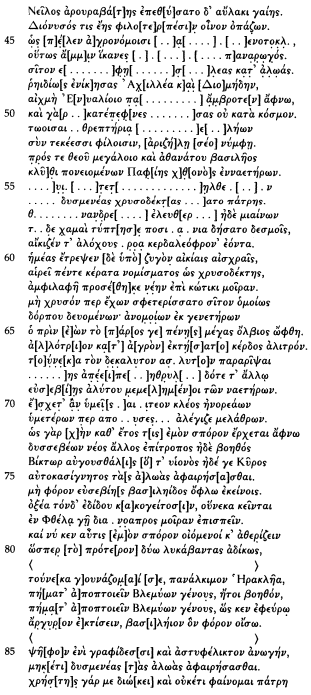

1–3 cf. 5,40–42 |
proleg. Sch-Wi 5 cf. 3,19; 5,47; 10,4; 11,4 6 cf. 11,10 ubi9–11 cf. 5,53–55; 9,1s.4; 10,1–3; 11,1–3 |semper P 12–14 cf. 5,59; 11,5–7; cf. etiam 1,6 19 cf. 10,4; 11,4 22 = P. Cairo Cat. I 67097 F 29; Aristoph. Th. 981, Pax 521 23sup. Cr 24 cf. 4,16; 12B 14; cf. etiam 6,28; 13,14; v. M. Leumann, Homer. Wörter 36ss 27 sup. P. Friedländer cl. AP I 19,3; cf. XXX 31 et Claudian. Gigantom. 7s 34 cf. 5,38; 8,4; BKT V 1 p. 115 v. 16s. 35=Wi (?) 3637 cf. 14,1 38 cf. 2,23 |Sch-Wi 39s cf. 2,3s 40 cf. Claudian. Gigantom. 6 41 cf. 6,8, sed etiam e.g. 19,8 |, cor. Ke 42s cf. 10 B 2s; 21,8 |add. leg. Sch-Wi, sed cf. 5,25s 45s cf. 5,17s 46 cf. 2,8 47velsup. Wi 48 cf. 2,19 50 cf. 1,10 51coni. P. Friedländer 52 cf. 2,30 54, cf. 13,14 57?Sch-Wi 59? Sch-Wi 62 codex 64 an postinterpungendum? 6567sconi. Sch 69 cf. 6,6 |7678 praefectus Augustalis Blemmyis stipendium solvit, quam pecuniam ab incolis exigit. post 80 (et 84) lacunam statuit Wi 81 cf. 2,21 82 cf. 2,7 |, coni. Wi 8587 Aegyptus ipsa loquitur 88'quantum ad colonos pertinet'; cf. 12 B 16 89 =90s '' Wi
O descendant of a divine and really golden line, I entreat you, lord of lords, I entreat you, patron of patrons, . . . the walls of Thebes and the sources of the Nile. . . . Let the whole Thebaid dance and welcome peace; for it shall not behold evildoing any more since fear of the spotless justice of the new Solon has sprung up everywhere. . . . Come, Grace and flowercrowned Joy, to . . . the bountiful and unconquered . . . , the fortunate and famous Duke, the most just ruler of all, who alone is the impartial judge who hates evil, skillfully shaped by the inimitable victories of glory. He does not bring back benefits (only) in the old way, having borne. . . . Dance for joy for a time full of celebration, without pain or envy. . . . Stretch forth your hand to me to relieve my poverty, stretch forth your hand to me in compassion so I may sing . . . O Muse, shed on me the new-fallen dew of divine eloquence, singing the harvest of a new theme of song, to compose songs of praise for the most excellent new Duke, son of golden-crowned and wise Justice and of strong Sarapammon, the Ammon of the Nile, renowned John, who is as the chief of lords. Like a father he has taught us the commands of the Emperor, and brandishes his proclamations in his hands that have written them. So do not be afraid to manage all things with a true rule; your name shines near to sovereign heaven, new
Phaethon of Egypt, the way it used to in another land: you have come as curator of our cities. Never, never was there anyone like you in noble descent in the realm of the Emperor; you have brought as a gift the everpresent help of the undefiled Trinity, single in essence. Under your leadership there has flowed forth the water that surpasses words, the Nile that covers Egypt's fields, that is poured out as an offering in the furrows of the earth. You come as a Dionysus giving your fellow revelers wine as their companion. As to the farmers, . . . so you come to us with every aid, . . . grain on our threshing floors. You have easily surpassed Achilles and Diomedes, the spearpoint of War . . . and not just in a worldly sense . . . nourishing . . . with your dear children and your admirable wife. By the mighty God, the eternal King, hear the suffering inhabitants of the land of Aphrodito. Wicked tax collectors . . . have shamefully beaten (men) to the ground and bound them in chains, torturing even women in their greed for gain. He has put us under the yoke with shameful torments, grasping at five keratia per solidus in his capacity as a tax collector; he has added on a new Doom in the huge Book. When he did not have money, he appropriated grain, like one without food. The one who formerly came from a dissimilar origin, and then was poor, seemed greatly blessed; but it was on someone else's land that he made his sinful profit. And so in addition . . . having been concerned with the firm piety of the inhabitants. You bring the glory of your noble deeds . . . caring for our households. As the wild goose returns every year, who of the impious will come upon my descendants to appropriate their threshing floors (their properties) now that Victor the augustalis is our prefect and helper, and his grandson, and Cyrus his own brother? May I not incur at their hands tax responsibility for the imperial piety. Give a hard time to those bad neighbors, because of whom . . . lie in wait to rule our fate even in the land of Phthla. And now, since right now they are concerned to dispossess my descendants, like the two years before, in their injustice, on their account I beseech you, brave Herakles, drive away our sufferings at the hands of the tribes of the Blemmyes, and help us, (drive away our sufferings from the tribes of the Blemmyes,) so I can find a way to pay the money in full for the imperial tax which I shall bear. Number among your writings too an unshakable command, so that wicked men do not appropriate our property. For my creditors are after me (Egypt), and I no longer seem the land of sowers that renders good service, because of previous payments of money. And grant your servant the sweet words her dear children say, to come home again in joy to their motherland, ever to exalt your boundless good will.
This poem, Dioscorus's chef d'oeuvre and his most extensive poetic statement about his world, is on the subject of justice. It is close to being a fair copy, written in Dioscorus's most careful Coptic-style slanted uncial hand, with only two cases of alternate versions of lines (24–25, 82–83) and without interlinear corrections. It has attracted comment since Schubart and Wilamowitz (BKT V, Berlin 1907), whose identification of John with the
praefectus praetorio Orientis of Edict 13 was corrected by J. Maspero, "Un papyrus littéraire d"

For (probable) depictions of the Duke of the Thebaid in Coptic art, cf. the ivory rider in Aachen (Volbach, Elfenbeinarbeiten, no. 77, Taf. 44) and the corresponding standing warrior (Beckwith, Coptic sculpture, pl. 107), together with the equestrian figure in the Walters Art Gallery (Volbach, Elfenbeinarbeiten, no. 86b, Taf. 47).
1. Cf. H5.40 with the parallels given in the note thereto.
6. Cf. H2.24 and H11.10, here combined, with note on H13.3, on the sources of the Nile in Olympiodorus's commentary on the Meteora. A perennial myth, and a source of fantasy and wonder, as well as matter for the speculative Alexandrian scientist.
8. On

16. (Cf. 11): the statement of the theme, justice.
18.


19.

22. This is the last line of Dioscorus's imperial chairetismos, P.Cair. Masp. I 67097 v F 27, published by MacCoull, "Imperial chairetismos," pp. 43–46. It is not discussed by B. Baldwin, "Dioscorus of Aphrodito and the circus factions,' ZPE 42 (1981) 285–286.
27. Wilamowitz (in BKT V) already noticed the Christian emphasis (

29. Cf. H23.13.

30. I agree with Cameron ("Pap.Ant. III.115," p. 127) that "son of Justice" is an epithet designating the duke by poetic personification, not a statement that the duke's actual mother was a woman called Dike (as Wilamowitz in BKT V). This is the genos in the panegyric.[82]
31. Ammon, the horned god of Thebes, was also, according to the Siwa legend, the real father of Alexander. The association would have been alive to Dioscorus. Could there be an identification with the Sarapammon, Constantinopolitan senator (with such a characteristically Egyptian name), of SB 9453 (PLRE II p. 977)?


33. An echo of the refrains in Ps. 118 LXX (e.g., v. 12) (Sahidic


34.


35.

36. John means "God is gracious"; cf. H18.3, and Milne in P.Lit.Lond. p. 78.
37. Dioscorus uses the shining figure of Phaethon here for the last time; cf. H14.1, H24.5 with note. The inference drawn from the second half of this line is that John has already held high office in another province, and is now reassigned to Egypt (BKT V p. 123). (Compare the way the recipient of Heitsch S10 [line 12] has been thought to have served in a Persian campaign; A. Körte in Archiv 5 [1913] 540.)
38. Cf. H2.23.
40. A deliberate echo of Ps. 45:1 LXX.
41. On this line and its parallel in H6.8 (Dioscorus's first and last
poems), see MacCoull, "A Trinitarian formula," pp. 103–110, and "



43. For

44. Dioscorus's last Dionysiac thiasos: it could be illustrated by such works of Coptic art as the Metropolitan tapestry, Dionysus holding grapes (Weitzmann, Age of spirituality, no. 121), or the Boston tapestry, Dionysus with wineskin (ibid., no. 123). The vintage festival would take place after the Nile flood (M. Schnebel, Landwirtschaft im hellenistischen Ägypten [MB 7, Munich 1925] 281–285).
49. Cf. H26.5, '́

50. See comment on H2.23.
54. Cf. H8.2 with comment.
56ff. These lines are a bitter indictment of the dark side of Dioscorus's world: contrasting Egypt's woes with the prosperity to be brought by the new regime of Duke John.
59. On violence to religious and women, cf. P.Cair.Masp. I 67002 III 2–3.
60. The subject of the (singular) verb is not specified but must be another of the exortionate pagarchs of Dioscorus's extensive experience.
61. Heitsch's text is misprinted (correct text in BKT V): read

62. This is a vivid image of the inescapable tax book looming over every Egyptian taxpayer. For the


codification," in Byzantine papers, ed. E. Jeffreys and M. Jeffreys (Canberra 1981) 12–31.
64. The villain's origins are of course base: a stock theme of invective.
66.


69. The theme restated: the root of justice is

72. On the image of the wild goose, cf. BKT V.1 p. 124 ("ägyptisch"). The flight of geese, as painted at the monastic site of Bawit, marked the changing seasons. The Egyptian wild goose or

74. Victor the augustalis is not to be identified with Victor the hegemon of H10. Cf. H17.7? Cyrus cannot be identified from the papyri.
76. On the meaning of


78. Phthla was identified by Maspero, "Papyrus littéraire," pp. 1–6. See P.Cair.Masp. I 67002. 14, 17; II 67134, 67135; III 67319, 67326, 67327; P.Lond. V 1660, 1665, 1666, 1677, 1686, 1689, 1702. See J. G. Keenan, "Village shepherds and social tension in Byzantine Egypt," YCS 28 (1985) 245–259.
80. Do the two years refer to Dioscorus's last two years at Antinoë (i.e., A.D. 571–573), during which more "injustices" had occurred at Aphrodito?
[83] J. Maspero's material presented in "Horapollon et la fin du paganisme égyptien," BIFAO 11 (1914) 163–195, is discussed by Karren, "Damascius' Life of Isidore," pp. xx–xxi, 15–21.
82–83. On the Blemmyes, cf. comment on H4 b 1.
85. For the meaning of


87ff. The poem closes with the affecting prosopopoiia of Egypt herself speaking, contrasting her fruitful and beautiful past with her present sufferings. On personifications of Egypt, cf., e.g., the ivory pyxis in Wiesbaden (sixth century: Volbach, Elfenbeinarbeiten, no. 105, p. 75, and Taf. 56); and cf. E. H. Kantorowicz, "The 'king's advent,'" in Selected studies (Locust Valley, N.Y. 1965) 57, for personifications of Egypt in representations of the Flight into Egypt. (Also a favorite subject was the fall of the old Egyptian idols at the approach of the infant savior.[84] ) A bold and deeply felt poetic device wrought by a poet of Egyptian consciousness.
88.

90.

91.

Egypt concludes her appeal to the duke by invoking his



This poem is also Dioscorus's most carefully and classically constructed logos prosphonetikos, following the rules of Menander Rhetor (ed. Russell and Wilson, pp. 164–171, 327–330). Our poet praises the duke's wisdom and administrative ability (line 29, cf. Menander 415.29 [with p. 329]), his background in another post (line 37), his civic activity (line 38), his
[84] The legend of the fall of the idols was already widespread in fifth-century Egypt (cf. Sozomen HE 5.21)—e.g., in the homily of Theophilus of Alexandria; see M. Simon, "Les écrits de Théophile d'Alexandrie," Muséon 52 (1939) 43–44, and M. Guidi, "La omelia di Teofilo di Alessandria sul Monte Coscam," Rend.Acc.Lincei ser. 5, 26 (1917) 381–390. It is commemorated in the Synaxarion on 24 Pachons; edited by I. Forget, CSCO 90.134–135. (This transmission took place in Arabic.) The later homily on the Flight into Egypt by Zacharias of Sakha, ca. 700, does not mention it; G. Giamberardini, II culto mariano in Egitto II (Jerusalem 1973) 37–42. The ps.Mt is a late, Western growth, but from old roots. (Rilke: 'platzten alle Götzen wie verraten . . ." [Marienleben, no. 8: "Rast auf der Flucht in Ägypten"]).
Trinitarian faith (line 41). The duke's virtue of temperance is exalted in his being compared with Diomedes (line 48, cf. Menander 416.20). The land he is to rule, Aphrodito, is lauded (lines 54, 90), and this praise is interwoven with that of the duke's courage in standing up for his subjects. The synkrisis, or final comparison, comes in the appeal put in the mouth of a personified Egypt herself. This involved and inclusive construction results in a memorable poetic production.
Dioscorus's last preserved venture into poetry, H3, produced a work that is deeply rooted in his own circumstances, deeply critical of what he sees as the ills of his society, and highly reflective of his own values and beliefs. It is a work of the genius loci (the Nile, the personification of Egypt), in which his own native Christian sentiments and his inherited education blend to produce a moment of happy opulence, a cry of outrage, and a vision of the better life all at once. This moment of vision is clothed in a language resonant with echoes of the syntax of his native Coptic speech, of the poetic foundations of the school curriculum, and of the carefully learned legal language (e.g., synonyms) of his public profession. It is imbued throughout with the quality of being steeped in the Scriptures, through the ubiquity of the Coptic liturgy and fathers. Dioscorus's work is the work of a man who prayed the Psalms after he had read the poets.
The Egyptian culture of Dioscorus's day was concerned with an

























































































































































































































